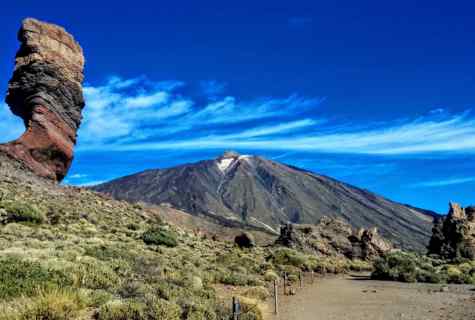Mount teide: Tours and activities on Mount Teide – Tenerife
Complete guide on how to get up Mount Teide peak
TABLE OF CONTENTS
- How to get up Mount Teide with a permit to climb to the top
- Obtain a permit to climb to the Mount Teide peak on your own
- Climb to the top of Mount Teide with one of the activities offered by the Volcano Teide Experience
- How to get up Mount Teide
- The most comfortable way to climb the Teide is by cable car
- The physical way: hiking up Mount Teide
- Our star excursion to the Teide Peak: Ascent to the peak by cable car
- No permit? No problem. The Teide is much more
- Frequently asked questions about getting up Mount Teide
- Mount Teide awaits you
Book your hiking tour in Tenerife
Climbing to the top of Mount Teide is an adventure that everyone must experience at least once in their life. Unfortunately, there are many ways to reach the Teide summit and so the best way in terms of means of transport, permits, activities, points of interest, excursions to the top of Mount Teide, etc. is not always clear.
There are two options for ascending Mount Teide: First, by cable car, travelling from the base station at an altitude of 2,356 m to the top station, known as La Rambleta, at 3,555 m. The second option is to hike to the peak via Montaña Blanca; the trail is around 9 km long and takes between 6 and 7 hours.
Since we receive dozens of calls every day from tourists who have doubts about how to get up Mount Teide, we have decided to write this complete guide with everything you need to know about how to get up Mount Teide and how to fully experience one of the world’s most impressive volcanoes.
But first, here are some spots and places of interest in the National Park. Their names will come up more than once, so if you get lost or are unsure of what we are talking about, you can always go back to this map:
Mount Teide location map
- Cable car base station, at an altitude of 2,356 metres.
- Cable car upper station, at 3,555 metres, also known as La Rambleta.
- Teide Peak, at 3,718 metres.
- Trail No. 10, Telesforo Bravo, to the Peak of Mount Teide.
- Trail No. 11 to the La Fortaleza viewpoint from where you can see the northern side of the island.
- Trail No. 12 to the Pico Viejo viewpoint from where you can see the southern side of the island.
- Trail No. 7 from Montaña Blanca (2,348 metres) to La Rambleta; the trail that leads to the Refuge.
- The Altavista Refuge, at 3,260 metres. (Currently closed to the public)
How to get up Mount Teide with a permit to climb to the top
Let’s start with the most important part: permits to climb to the Mount Teide summit.
Reaching Mount Teide’s highest point is not easy, but only because you need a permit for it.
Hikers at the Peak of Mount Teide
To hike to the top of Mount Teide you need to take trail No.
So, how to get up Mount Teide with this permit? Here are your two options:
Obtain a permit to climb to the Mount Teide peak on your own
For this option, you only need to carry out one step: visit the National Parks reservations website with sufficient time in advance.
How much is sufficient?
That depends on the season, sometimes you need more than three months. This is because only 200 permits are allocated per day and demand is very high. If you have tried and were unlucky, don’t worry, there are other options.
Climb to the top of Mount Teide with one of the activities offered by the Volcano Teide Experience
The second option is to join one of our activities that take you to the Teide summit.
We won’t go into more detail here, but if you need more information on how to get up Mount Teide with this option, you can find it in this post which we have prepared for you about how to get the Mount Teide permit.
And if you’d like to book the activity with us, you can do it here.
How to get up Mount Teide
Let’s move on from the ‘legal’ side of hiking up Mount Teide to talking about how to get up Mount Teide as comfortably as possible.
There are two ways to climb Mount Teide, and by ‘climbing’ Mount Teide we mean reaching the very peak, the highest point in Spain.
You have two options again:
The most comfortable way to climb the Teide is by cable car
The cable car links the base station with La Rambleta in a fascinating 8-minute air journey. Not only is it comfortable and fast, it is also an easy and fantastic way to visit the volcano and discover this natural treasure.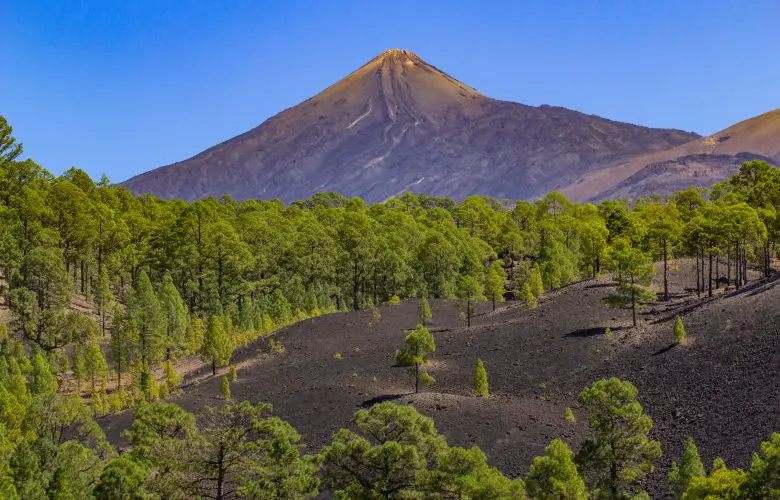
Ascent to the Peak of Teide by Cable Car
There are two ways of climbing the volcano by cable car. The first option is to go it alone; you will need a lot of planning ahead: you have to apply for a permit, and once it has been approved, you have to purchase the cable car tickets and book a time that is compatible with that permit.
But the second option is much more convenient: book our excursion to the top of Mount Teide. We will process the permit for you, include cable car tickets for just the right time and as an added bonus, the tour includes an official guide from the National Park who will be able to help you discover all the wonders of this natural paradise that you might otherwise miss.
For more information, simply click on this post in which we present detailed information on how to get up Mount Teide by cable car.
I want to book the excursion with the Cable Car
The physical way: hiking up Mount Teide
If you are looking for a challenge, congratulations! You have found one of the best.
Hiking up Mount Teide is not for everyone. It is quite steep in some sections, the atmospheric conditions harden the further up you go and the wild volcano vegetation can seem torrid, although the scenic value given by a climb to the peak makes the hike well worth the effort.
Ascent to the Peak of Teide on foot via Montaña Blanca
The route that allows you to climb to the Mount Teide summit by foot starts at the foot of Montaña Blanca—pun intended—and ends at the peak, but the path itself has several stages. If you want to discover them all, take a look at our post that we prepared specifically for it:
I want to book the ascent on foot
Our star excursion to the Teide Peak: Ascent to the peak by cable car
Let’s take a quick break.
We have already talked about how to get the permit and how to get up Mount Teide. We also provided you with links which include very specific information for your visit.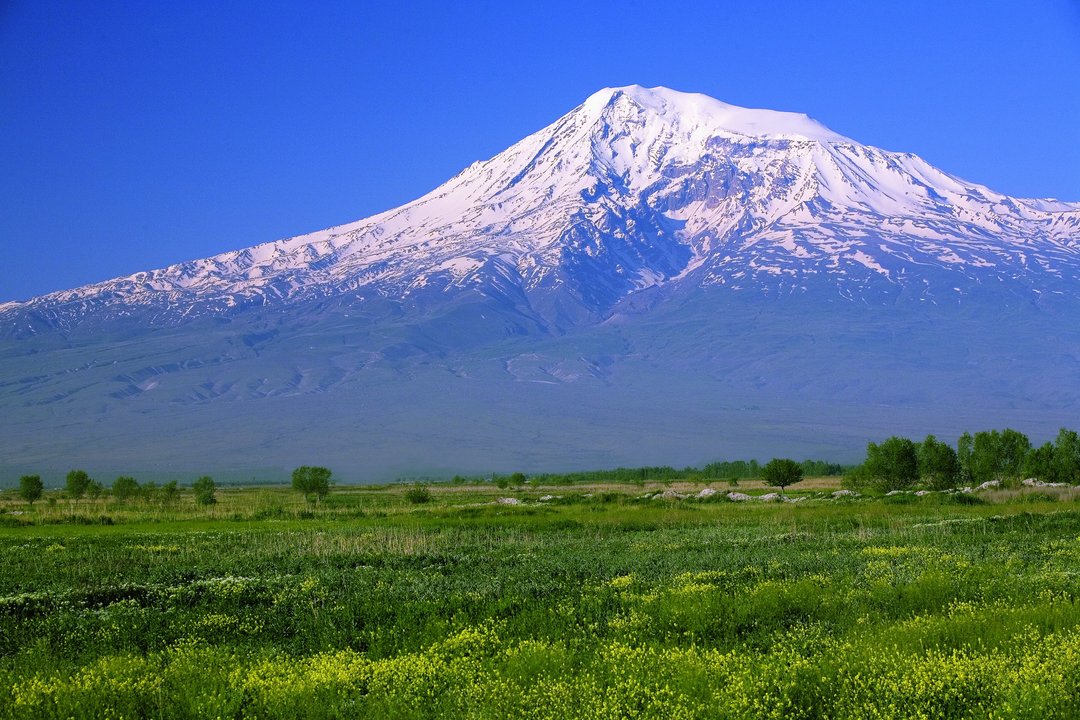
Now it’s time to tell you about our best excursion to the Mount Teide peak. The one most sought after, even by the island’s residents. And it is simply amazing…
We are referring to the Ascent to the Teide Peak by Cable Car excursion, which includes transport from your accommodation.
Excursion to get up Mount Teide by cable car
The excursion to the Teide peak, generally speaking, allows you to:
- Reach the top of Mount Teide: And it includes the permit!
- Enjoy the company of an official guide from the National Park who will show you all the secret corners on the volcano and teach you about the natural heritage of the highest volcano in Spain.
- Climb from the base station to La Rambleta by cable car, comfortably, on an 8-minute trip over a geological treasure that will offer you postcard views.
- Hike the very popular Telesforo Bravo trail that will take you to the Mount Teide crater.
Book the Ascent to the Teide Peak by Cable Car excursion
And if you are looking for excellence and exclusivity, the VIP ascent to the Teide peak excursion includes the same activities, but with no-one else in the group: The guide is completely dedicated to you. They’ll be there with you whenever you need them, something you’ll appreciate when you set off on the amazing Telesforo Bravo trail, which reaches the peak.
Take me to book the VIP option
How to get up Mount Teide: on foot of by cable car
No permit? No problem. The Teide is much more
Climbing Mount Teide is sooooo much more than simply reaching the peak. The volcano offers a wide range of interesting things, it would be a crime to limit yourself to simply climbing it.
For example, trail No. 11 will take you to the Mirador de La Fortaleza viewpoint. This trail crosses an, apparently chaotic, sea of lava that is testament to the tremendous forces that created it.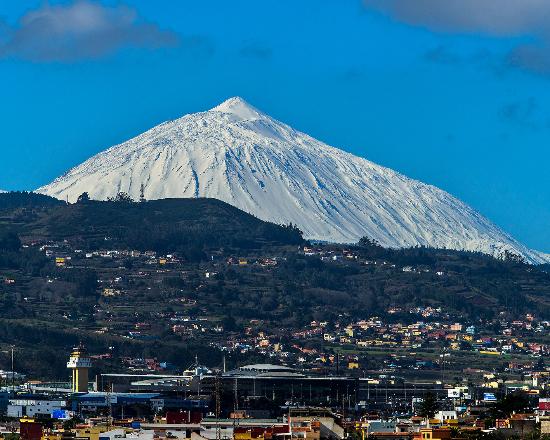
La Fortaleza Viewpoint trail
Trail No. 12 to the Mirador de Pico Viejo viewpoint is also highly recommended. It is a volcanic path that will guide you across ancient lava rivers. You will pass fumaroles that will add a wild side to your excursion, and the smell of sulphur will remind you at all times that the Teide is an active volcano, even though it is dormant.
Pico Viejo Viewpoint trail
Go it alone with the cable car ticket if you want, but we recommend that you don’t miss a single thing and trust our guide to accompany you during this fascinating tour. Our guided tour also starts at La Rambleta, and at the end of the trail you will reach a viewpoint overlooking a 800-metre crater covered with every colour in the rainbow! Literally. So don’t miss it.
I want to book the guided tour to the Pico Viejo Viewpoint
But wait, there’s another option for hiking up to the top of Mount Teide: the same guided tour we mentioned before is also available at dusk.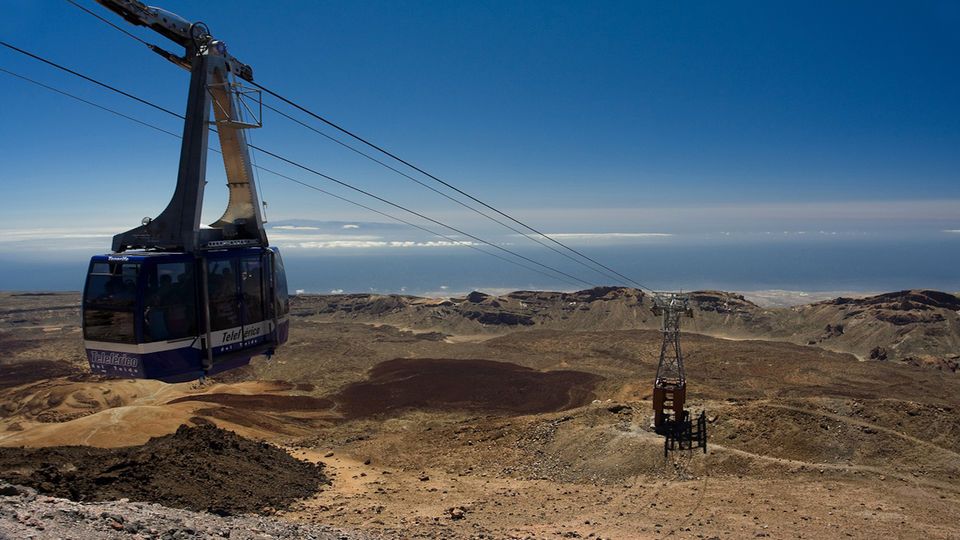
Sunset on Mount Teide from the Pico Viejo viewpoint
I want to behold the sunset on Mount Teide
If you want more information on any of these options on how to get up Mount Teide, or if you were not able to get permit or book a trip to the Mount Teide summit, here is the relevant post:
Frequently asked questions about ascending to the peak of Mount Teide
Below you’ll find helpful answers to the most frequently asked questions that we receive about ascending to the peak of Mount Teide:
How long does it take to ascend to the peak of Mount Teide?
It depends how you do it. Hiking up from Montaña Blanca to the peak takes around 5 to 6 hours. If you ascend by cable car to La Rambleta and walk up from there, it will take roughly 40 to 50 minutes. Please bear in mind that these times are for guidance purposes only and the duration significantly depends on your level of physical fitness.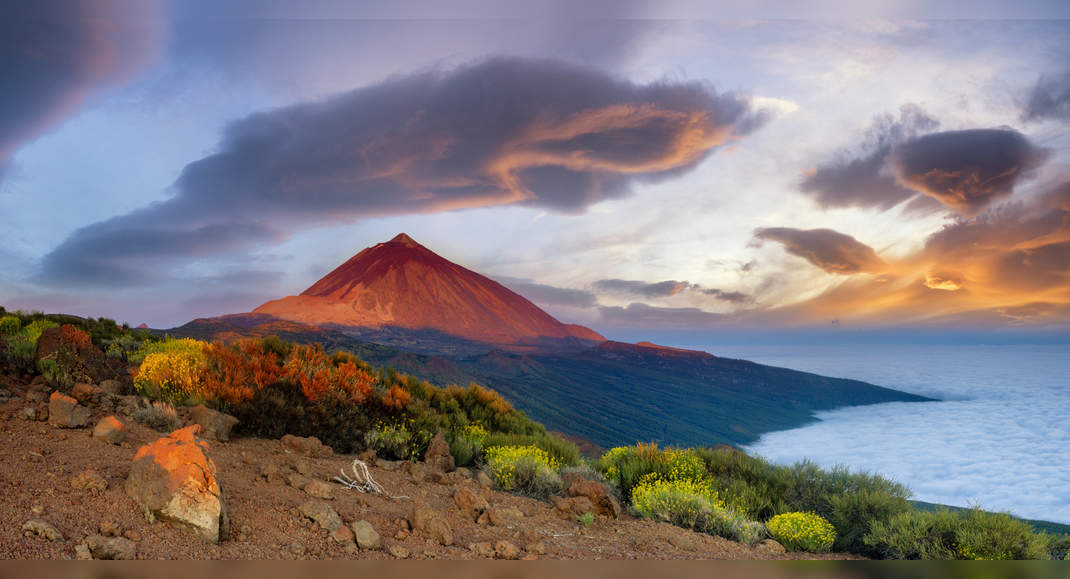
How much does it cost to ascend Mount Teide?
There are several differently priced options for getting up Mount Teide because the available activities may include transport, a guided tour, an audio guide, etc. Activities also take place during the day, at sunset, or at night to observe the stars.
Here’s a link where you’ll find up-to-date information and prices.
Which is the best road for going up Mount Teide?
Fortunately, distances in Tenerife are always short. In fact, the distance to Teide from the main points of the island ranges between 45 and 64 km, which means that to visit Mount Teide you can go up using one road whose main access is near the area where you are staying, and to go back you can use another road, allowing you to enjoy completely different landscapes, and return to the starting point on the same day.
How do you get a permit to ascend Mount Teide?
The best way to get an answer to this question is by reading a post in which we describe in detail all you need to know about the Mount Teide permit.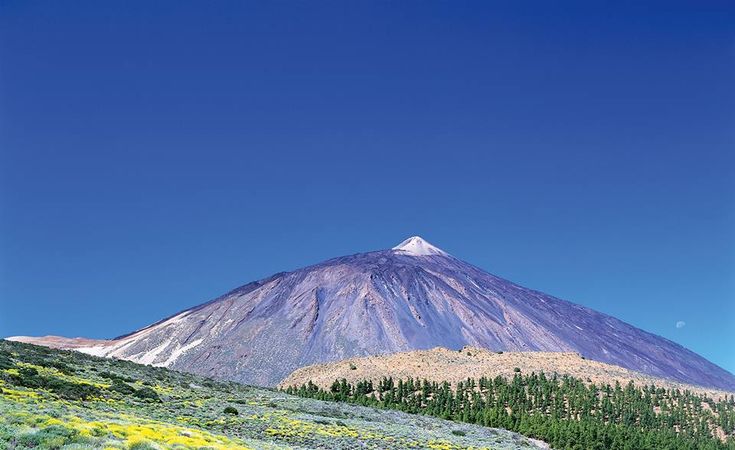
How long does it take to go up Mount Teide by car?
As we explained above, distances in Tenerife are always short and this is a big advantage. Below are details about the approximate distance between the most popular points on the island and the route to Mount Teide up to the cable car base station:
- Santa Cruz: 64 km.
- La Laguna: 55 km.
- Puerto de la Cruz: 45 km.
- Los Gigantes: 52 km.
- Los Cristianos: 47 km.
- El Médano: 52 km.
Mount Teide awaits you
The highest mountain in Spain receives every traveller with open arms. The third highest volcano in the world measuring from the bottom of the ocean and a National Park that extends the length and breadth of its slopes is a treasure worth discovering and an ideal place for those who love visiting the unknown.
It is an essential visit on your holidays to Tenerife; its exceptional state of conservation and surprising range of opportunities mean you won’t regret a second.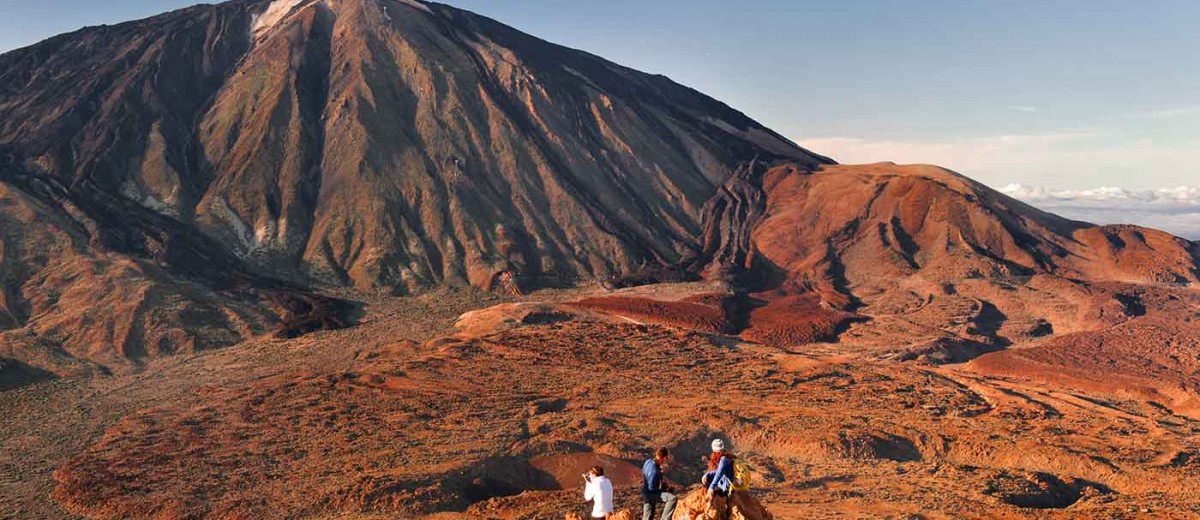
This is where we say goodbye. If you would like to review all the activities on offer by the Volcano Teide Experience, including an excursion to the top of Mount Teide, here is a weekly calendar. It will help you decide how to get up Mount Teide and plan your climb up to the peak.
Mount Teide Tour with Cable Car – Tenerife
A Mount Teide Tour with cable car that has everything you need
On this organised Mount Teide Tour with cable car (optional) return tickets, you’ll discover Teide National Park: the most visited national park in Europe. You’ll also be visiting the park in a sustainable way.
From the comfort of our bus and accompanied by an official guide, you will discover scenery that will leave you wide-eyed with wonder as you ascend towards the peak. Because Tenerife is an enormous mountain in the middle of the ocean. Its roads climb to reach the heart of the island: Mount Teide. Along the way, you will pass through different bioclimatic levels.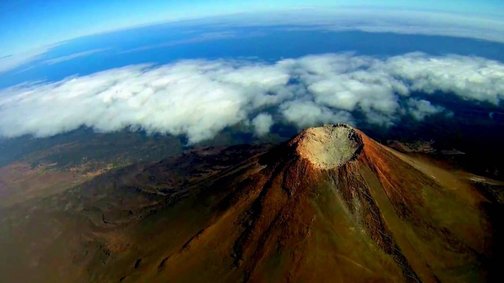
As you leave the coast, made barren by endless sunshine, the proximity of the sea and the lack of rain, you will enter the mid-altitude zone. This contains the finest agricultural land, chosen by the European settlers as the site for Tenerife’s historic towns. A series of towns is strung like a necklace at a mid altitude of between 400 and 500 metres above sea level: Arona, La Orotava, Santiago del Teide… All still conserve a historical legacy worth discovering.
If your Teide excursion takes you up the north side, the likelihood is that from 600 metres above sea level you will be engulfed by dense fog. You will be in the belt below the area of direct impact of the moist trade winds that blow in from the north-east, forming a sea of cloud. Here, laurel woods clothe the scenery in a rich green colour, and you will feel a coolness that will make you reach for your coat. Soon, at an altitude of 1,000 metres, the laurel woods give way to dense, humid pine forests, that extend up to 2,000 metres.
When you reach the high mountain area, you will see the sea of cloud at your feet, and you will feel as if you are flying above it. The flora of Las Cañadas comprises broom, laburnum and a vast array of other plants, most of them endemic to these peaks. Here, the extreme climate, with significant fluctuations between summer and winter, and even between day and night, determines the pattern of life. Scrub clothes the slopes of the Las Cañadas cirque, and those of Mount Teide itself. But as you make your way towards the peak, it gradually disappears… Only the beautiful Teide violet survives at 3,000 metres on the volcano.
And throughout your trip to Mount Teide, you will see the volcanoes that formed Tenerife, some as old as the island itself, and others more recent.
Furthermore, since (optional) cable car tickets to go up Mount Teide are already included, you don’t have to worry about missing the chance to book your seat.
Enjoy spectacular views of Tenerife and some of the neighbouring islands on this excursion to ascend Mount Teide
Our Teide Tour includes tickets for the ascent and descent (optional) to take you up to an altitude of 3,555 metres so that you can enjoy stunning views of Tenerife and some of the neighbouring islands, whilst at the same time seeing one of the world’s most extraordinary volcanic landscapes. On Las Cañadas, you will see different types of lava and volcanic rock formations, beginning with Mount Teide itself, a stratovolcano of the Vesuvian type.
Mount Teide was formed gradually, as eruption followed eruption. Each eruption added another level to the volcanic edifice. Mount Teide began as a small volcanic cone at the base of Las Cañadas 150,000 years ago, and reached a height of 3,718 metres 1,000 years ago, when its most recent eruptions occurred; these formed the current peak and the streams of black lava that flow down its slopes.
When you reach the cable car upper station, you can choose which views you’d like to enjoy:
- Admire Siete Cañadas and the Ucanca valley from La Rambleta viewpoint
- Follow the La Fortaleza trail and enjoy spectacular views of northern Tenerife
- Choose the Pico Viejo viewpoint trail and admire views of southern Tenerife with the impressive 800-m-diameter Pico Viejo crater at your feet and, if the weather permits, the islands of La Gomera, El Hierro and La Palma on the horizon.
Come on a Mount Teide Tour with cable car and visit Mount Teide in a sustainable way
Forget the car and contribute to a sustainable Teide. By reducing atmospheric pollution, you can help in the fight against climate change.
By choosing group transport you’ll help to beat overcrowding in the vehicle parking zones inside the National Park which, as a conservation measure, are small and unsuitable for expansion.
Did you know that by choosing to visit the National Park and ascend Mount Teide by cable car on this excursion you can forget having to circle around in your car until you find a parking space?
Can you imagine a better excursion than this Mount Teide Tour with cable car?
We already know which will be your favourite excursion: Mount Teide Tour in Tenerife!
Highlights…
- Mount Teide Tour with cable car (optional) and a guide
- The most sustainable way to visit Mount Teide: in group transport
What’s included…
- Teide Cable Car return ticket (optional)
- Official Spanish, English, German and French-speaking guide
- Transport from the north and south of Tenerife to visit Mount Teide in a sustainable way
What’s not included…
- Food and/or drinks
- Permit to access the Teide crater issued by the National Park
- Guide in other language than Spanish, English, German or French
- Access for visitors with physical disabilities or motor impairments
Mount Teide National Park, a volcanic wonder
With a height of 3,718 metres, Mount Teide, the third largest volcanic structure in the world, watches over Tenerife like a guardian of the island, as a symbol of the force of nature.
Mount Teide volcano, the park’s undisputed star
Created in 1954, Mount Teide National Park is located in the heart of Tenerife and comprises, in addition to the tall peak, a large caldera known as Las Cañadas del Teide. Mount Teide is accompanied by Montaña Blanca and Pico Viejo (or Montaña Chahorra). It is a young volcano that is just 600,000 years old and it is said that from the top you can see the other Canary Islands.
Free cancellation
The park covers nearly 19,000 hectares, with a maximum diameter of 17 kilometres in the shape of a caldera, and boasts unique vegetation.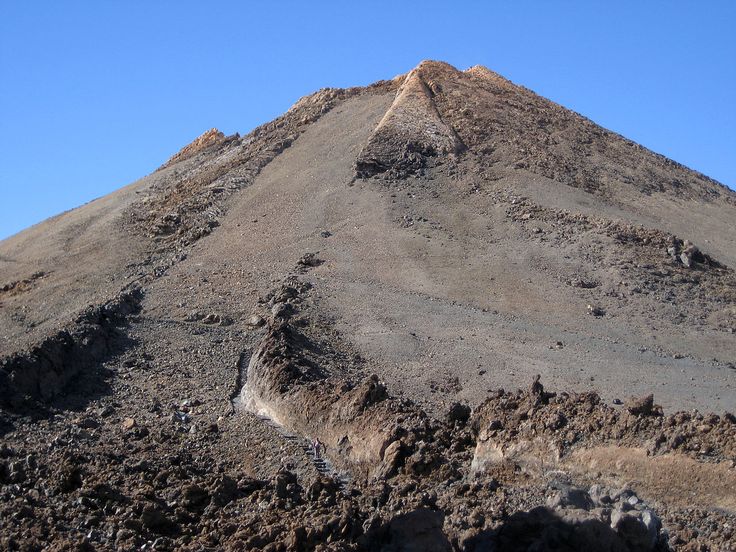
Teide National Park
The fauna of the Teide National Park is very difficult to observe, although if you pay attention, you can spot the Gallot’s lizard, endemic to the western Canary Islands; the North African hedgehog, the common kestrel or the sparrowhawk.
One thing you cannot miss is the spectacular landscape and scenery of great beauty, which is why a visit to Mount Teide is a must on any trip to Tenerife. It seems that the last eruption of the volcano was in 1492 and it is believed that Christopher Columbus himself may have observed it from La Gomera.
Excursions to Mount Teide National Park
Historically, Mount Teide has attracted great explorers and travellers eager to reach its summit, such as Feuillée (1724), Edens (1751), Heberden (1752), Borda (1776), Macartney (1792), and Humboldt, to name just a few. Today, four million people come to the park every year, usually for a day trip. And many of them make it to the Teide crater.
Below you will find some of the many options to enjoy the Teide National Park:
Teide Cable Car
The Teide cable car is open from 9:00 AM to 5:00 PM. It departs from the base of the volcano, located at 2,356 metres, and goes up to La Rambleta, at an altitude of 3,555 metres, from where you can continue ascending to the summit of Mount Teide on foot. Please bear in mind that a special permit from the park’s authorities is required to access the crater. The Teide cable car was inaugurated in 1974. The journey lasts 8 minutes and crosses the corridor called La Corbata del Teide [the Tie of Mount Teide], offering a beautiful panoramic view of Las Cañadas.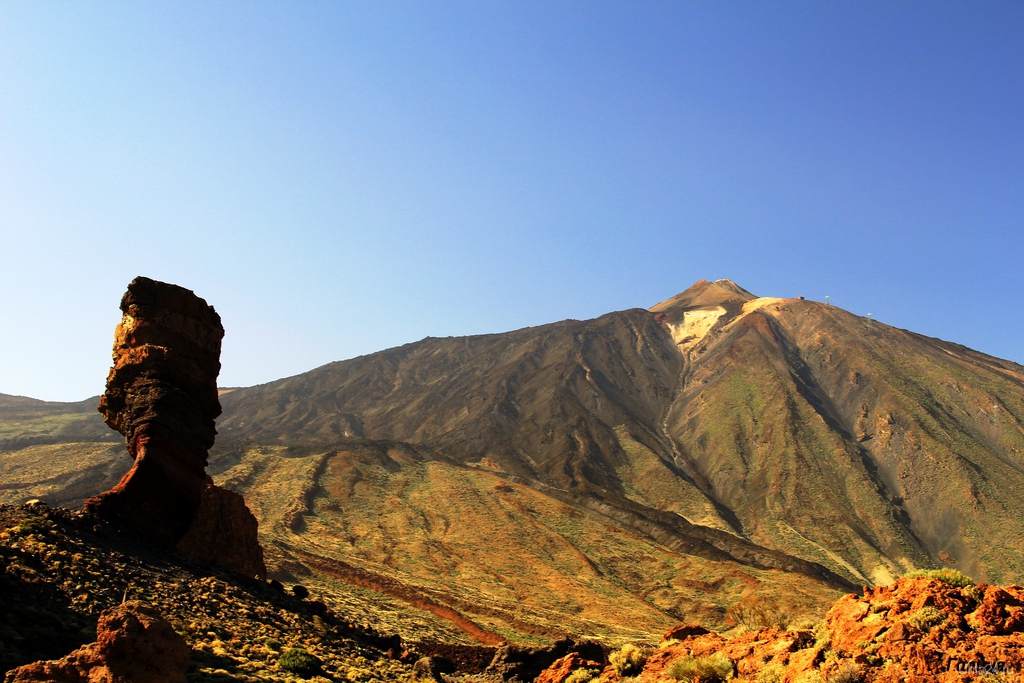
Teide cable car
Hiking around Mount Teide
There is a network of hiking trails around Mount Teide, so there are multiple possibilities to walk through the territory overseen by this volcanic giant. The longest route is the one that surrounds the peak and runs through different cañadas (former cattle routes). Although you can start the hike anywhere, we recommend starting at the El Portillo visitors’ centre. The walk can take hours, but it is worth it because it allows you to discover each side of Mount Teide, as well as its secondary volcanoes (Montaña Blanca and Pico Viejo—or Montaña Chahorra—etc.). You will cross spectacular black lava fields, in the middle of an astounding silence that is only broken by the wind or by the singing of some birds.
Visiting Mount Teide
Only expert hikers can plan the ascent to the summit of Mount Teide, because the experience is challenging.
Tenerife Experiences
½ day Teide National Park tour
from 29€
BOOK
Climbing the Montaña Blanca
An easier excursion is following the trails up to the Montaña Blanca or completing the Huevos del Teide [Teide Eggs] route, dotted with large black balls of volcanic rock, which were expelled from the volcano during its last eruptions. You can also walk along the so-called Roques de García—vertical monoliths which can be found next to the Parador de las Cañadas del Teide hotel.
What to see in the Teide National Park
Cañada Blanca Visitors’ Centre (Parador Nacional de las Cañadas del Teide). It is located to the side of the hotel and is open every day from 9:00 AM to 4:00 PM. Here you will find information about the relationship between man and nature, and the wealth of the National Park. You can also book free guided walking tours to climb Mount Teide. The hotel has a cafeteria-terrace facing the volcano from which you can behold a breathtaking landscape. There’s another visitors’ centre in the park—Portillo de la Villa—which has the same opening hours.
Botanical Garden. It occupies a 4-hectare plot next to the Cañada Blanca visitors’ centre and was created to exhibit, research and reproduce the native flora of the national park. In fact, specimens of 75% of its species can be found here. Some of them, like the famous Teide violet, do not adjust to the climate, as they need a higher altitude.
Tenerife Experiences
Teide under the stars with winery and dinner
from 61€
BOOK
Roque Cinchado. This rock—or rather remnants of volcanic materials moulded by erosion—also known as Árbol de Piedra [Stone Tree], is a monolith carved in volcanic stone. It has become an emblem of the park, being one of the most photographed elements with Mount Teide in the background.
Caution: Visitors must not stray from the marked paths nor leave the signposted areas in the national park. Failure to observe this rule may have very serious consequences for this giant carpet of volcanic ash.
Free cancellation
Teide National Park
Mount Teide is the third tallest and largest volcano on the planet after Mauna Loa and Mauna Kea in Hawaii. Teide is the highest mountain in the Canary Islands (and in all of Spain.) Its formation began 170,000 years ago after a giant slide of the previous volcano which was even larger than the current one.
- Ascent to Teide
- Ascent to Teide by cableway
- Hike up to Teide on foot using the trails
- There are several options.
- Trail 7 from Montaña Blanca to La Rambleta
- The First section: Montaña Blanca – Teide Base
- The Second section: Teide Base – Refugio de Altavista
- The Third section: Refugio de Altavista Refuge – Teide peak
- Trail 12 to the Pico Viejo viewpoint
- Trail 11 to Mirador de la Fortaleza
- Recommendations for the ascent to Teide Volcano
- Climbing at over 2,000 meters a.s.l. in Tenerife
- The routes of La Catedral and the Roques de García
- How to get there:
- By car:
- By bus:
- Where to stay
The volcano strata grow due to the overlapping lava layers in the course of successive eruptions.
According to the beliefs of the Canarian indigeneious peoples (Guanches), Guayota, the king of evil, aka the demon, lived inside Teide (hell) and kidnapped the god Magec (the god of light and sun) taking him inside Teide. The Guanches prayed Achaman, their supreme god, for mercy. Achaman managed to defeat Guayota, removed Magec from the bowels of Mount Teide and plugged the volcano’s crater. They say that the stopper Achaman put on is the last cone of the volcano, it is whitish in color and crowns Mount Teide.
Statues of Guanche kings Guize and Ayose on Fuerteventura, Canary Islands
In the ancient classical world, Mount Teide aroused great fascination. Thus, the Greek historian Herodotus mentioned Teide on two occasions: “The Atlantean is outstanding as a cylindrical figure.
In his work “Natural History”, Pliny the Elder, a Roman writer (AD 24-79), mentions the snow that King Juba and its envoys saw on the islands: “Cloud-covered Ninguaria which received this name for its perpetual snows.”
During the Renaissance, many historians and adventurers began to identify and relate the Atlantic islands with the remains of the Atlantis, and Mount Teide with Mount Atlas, the Canary Islands representing the highest parts of the lost sunken continent.
Due to its imposing altitude, during the time of the European expansion, El Teide was considered the highest mountain in the world, since it was used as a beacon in navigation through the Atlantic Ocean to the south by Spanish, Portuguese, and British sailors.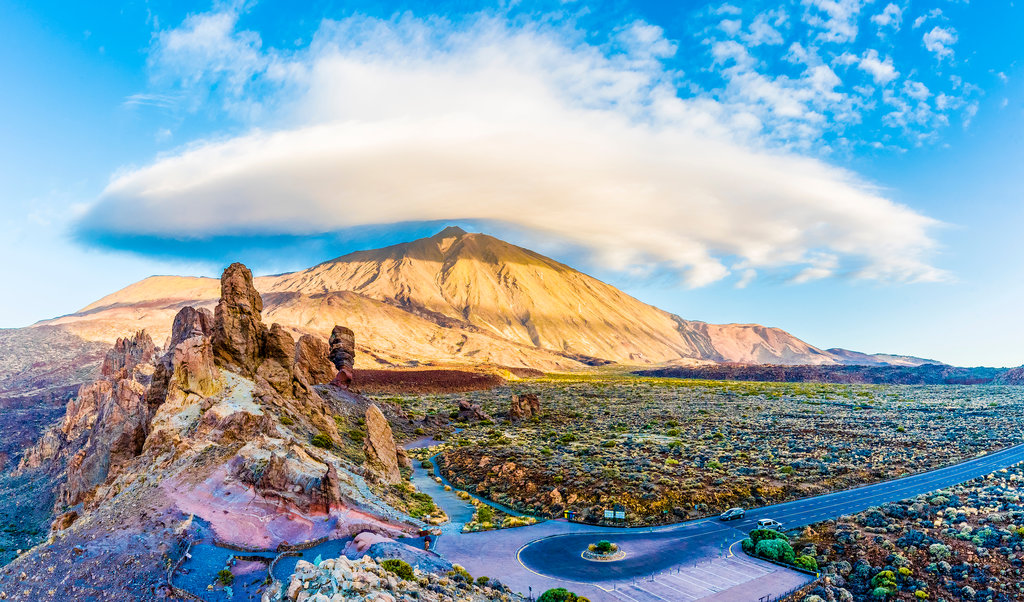
From the geomorphological point of view, Teide is a sheer wonder of nature. The structure of the caldera and the Teide-Pico Viejo stratovolcano are unique on the planet. The vicinity is also well-worth the visit. There are hundreds of cones, castings or caves that enrich scientific and landscape interest of the researchers. We need to add its wealth of fauna and flora to the mix, with a large number of Canarian endemics and unique species.
The Teide National Park was created in 1954 in recognition of its volcanic and biological uniqueness. It covers almost 19,000 hectares, which makes it the largest and oldest national park in the Canary Islands. It has a Peripheral Protection Zone, and is surrounded by the Corona Forestal Natural Park, which, with 46,612.9 hectares, is the largest protected natural area in the entire Canary Islands.
Touring the area, even by car, is a sight to behold. The landscape is overwhelming no matter where you look. To get to know it in greater depth, it’s best to go up one road and go down using another one.
Ascent to Teide
Some people decide to make the ascent to Teide in the fastest, easiest and most comfortable way, that is, taking the Teide Cableway (2,356 to 3,555 meters above sea level) and accessing the Telesforo Bravo trail (Teide peak) thanks to a previously requested permit. On the other hand, there are those who decide to hike up and enjoy Montaña Blanca trail, one of the most impressive trails on the island of Tenerife.
The Teide National Park is the most visited park in Europe (and one of the 10 most visited in the world) as well as the World Heritage Site since 2007. Its visit is totally mandatory during a trip to the island of Tenerife.
For many, Teide is an unknown volcano. Some even cannot fathom that it’s an active volcano.
Ascent to Teide by cableway
Teide is 3,715 meters above sea level. At 2,356 meters a.s.l, there’s the Teide Cableway that rises from 2,356 m to 3,555 m in just 7 minutes.
During the ascent on the Teide cableway, you go along one side of the volcano enjoying magnificent views of the great Caldera de las Siete Cañadas and you are located just 163 meters below the highest point of the volcano, the crater or Pico del Teide. We recommend buying the cableway tickets in advance, if you choose to do it with an audio guide you will be able to roam freely along the path to the Mirador de Pico Viejo and the Mirador de La Fortaleza.
The Teide Cableway costs 13.5 EUR one way. It’s open from 9am to 5pm if the weather allows it, which happens most of the year.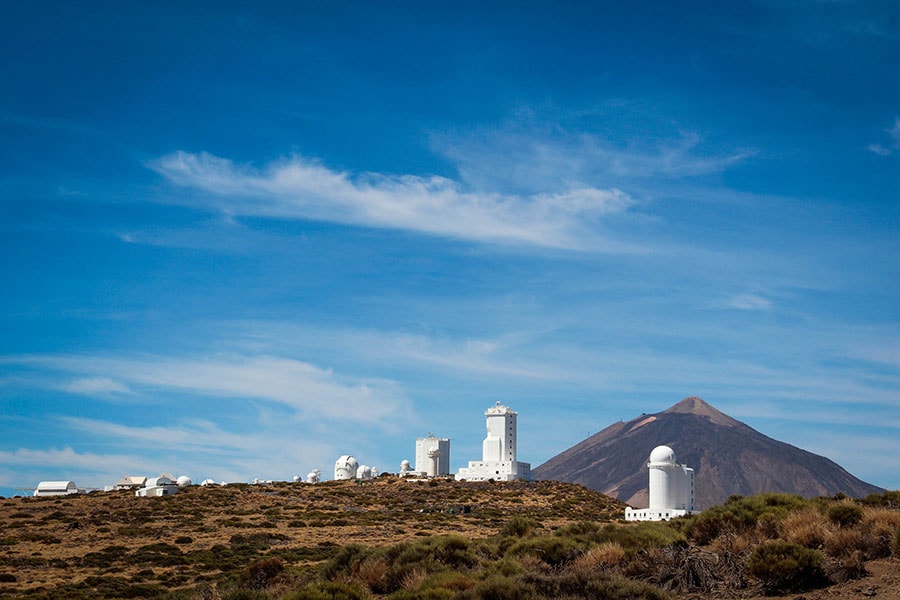
This option is very worthwhile for those who don’t want to spend a full day hiking on Teide volcano. You have different options of getting on and off the Teide Cableway, walking up and down the cableway, etc.
Hiking up to Teide peak is possible via trail number 10, the Telesforo Bravo trail. Normally, it takes about 35 minutes to do this walk. It’s a well-marked and short trail (less than 1 kilometer), however, the lack of oxygen is quickly noticeable (20% less at this altitude), thus if you have any issues with cardio-vasclular system, consult your doctor before going up.
Hike up to Teide on foot using the trails
Getting the permit issued by the Teide National Park management can be quite a challenge. Not because of the technical difficulty, but because there are many requests and not too much availability: only 200 permits are issued per day.
What can you do if you can’t get a permit? What are the alternatives to hike up Teide without a permit if you haven’t arrived on time to obtain the free permit that allows you to reach the top?
There are several options.

Please note it’s not possible to hike up Teide peak without a permit unless you spend the night in Refugio de Altavista, but there are alternative activities if, for whatever reason, you can’t get a permit to hike up Mount Teide on your own.
The following are some important viewpoints and trails within the National Park that will be mentioned with some frequency during the rest of the article:
- Cableway base station, at 2,356 meters of altitude.
- Cableway upper station, at 3,555 meters, also known as La Rambleta.
- Pico del Teide (Teide peak), at 3,715 meters.
- Trail 7 from Montaña Blanca to La Rambleta, which leads to the shelter Refugio de Altavista.
- Trail 10 from Telesforo Bravo to the peak of Mount Teide, accessible only with permit or an overnight stay at the refuge.
- Trail 11 to Mirador de la Fortaleza, with views of the north side of Tenerife.
- Trail 12 to Mirador de Pico Viejo, with stunning views of the southern slope of the island.
Trail 7 from Montaña Blanca to La Rambleta
The start point of the hike to Teide is the trail of Montaña Blanca which offers more than a dozen parking spaces. The trail is very well signposted from the road with a sign that says Montaña Blanca and Refugio de Altavista.
The ascent walk to Mount Teide can be done over one morning if you ascend on foot and descend by cableway, for example. Or, you can start in the afternoon and stay overnight at Refugio de Altavista (located on Teide volcano) and thus ascend to the early morning peak to enjoy the sunrise.
Getting to Teide peak from the Montaña Blanca trail takes approximately four and a half hours.
The total length of the trail is 8.3 km with a maximum difference of 1,350 meters, so the difficulty of this trail is high.
The First section: Montaña Blanca – Teide Base
The first part of the walk or hike to Teide consists of walking along an almost flat path of approximately 5 kilometers.
The pumice stone is the highlight of the beautiful scenery. In some areas, it surrounds large accretion balls (the most famous of which are known as “Huevos del Teide”) in order to break the almost bleak monochromaticity of the soil.
This section is completed in about an hour and a half and during this part we can see the north of the island of Tenerife, the Izaña region (the Teide Observatory), and La Fortaleza. This walk is simple and the most comfortable part of the trail.
The Second section: Teide Base – Refugio de Altavista
A sign with a large map marks the beginning of trail number 7, known as La Rambleta.
Here is where the real ascent to Teide volcano begins.
The lack of oxygen is noticeable in this part of the trail due to the altitude, but the landscape is breathtaking.
Finally, we reach Refugio de Altavista, which is nothing more than a small high mountain house. It has a living room with a fireplace, kitchen, bathrooms and several shared rooms with bunk beds, everything is very simple and rustic.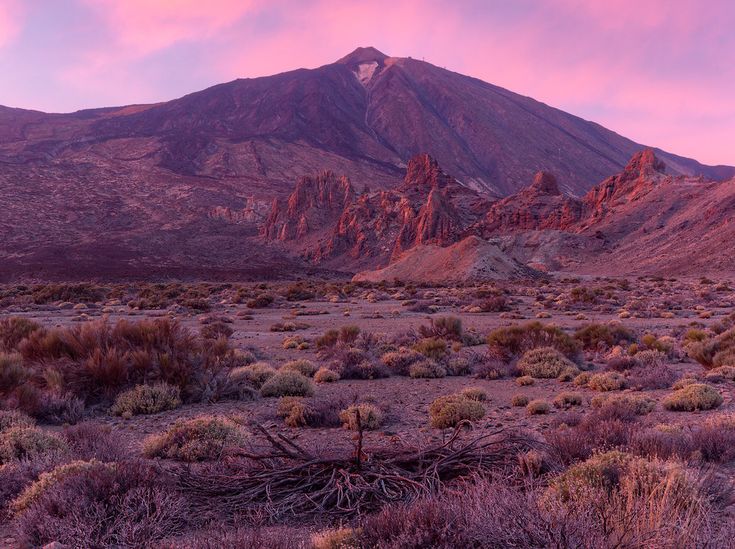
From there, it’s possible to discover the constellations of late summer: Cassiopeia, Drago, Ursa Minor, Pegasus, the summer triangle, Escorpius, Sagittarius and some others if you know your astronomy well.
The Third section: Refugio de Altavista Refuge – Teide peak
There’s a trail behind the shelter that leads to the cableway. Located at 3,555 metres above sea level, the cableway trail ends in about 7 minutes, in the area of La Rambleta. From this point, there are only 163 meters left to reach the crater.
During this last section, the wind intensifies, you can smell the sulfur and your heart will probably beat faster.
If the weather is good enough, it’s possible to see all the islands of the Canary archipelago.
It takes about 3 hours to complete the ascent from Refugio de Altavista to the Teide peak.
Trail 12 to the Pico Viejo viewpoint
Of all the alternatives to hike Teide without a permit, this is without a doubt the most recommended.
The Pico Viejo trail starts from La Rambleta and ends at a viewpoint with views of the crater of Pico Viejo volcano. It takes 30 minutes and 751 meters to reach the point. It’s of medium difficulty.
The beauty of this journey is not only the end at the viewpoint, but the trail itself, which is one of the most beautiful viewpoints in Spain.
The Pico Viejo trail begins with panoramic views of the Caldera de las Cañadas, which today marks the limits of the Teide National Park. As you progress, you will find solid yellowish remains, a work of the gases expelled from the bowels of the volcano that is still active. There are fumaroles on the sides of the trail and other spectacular formations such as the famous Corbata del Teide or Roques de García.
After walking through tongues of lava along the path of great scenic and volcanological value, we arrive at the viewpoint from which you will see the peculiar crater of the Pico Viejo volcano.
It’s 800 meters in diameter and has a variety of unbelievable colours.
There’s a chain of volcanoes in the background, the Teno massif and the islands of La Gomera, El Hierro and La Palma.
The return will be made by the same trail, and at the end you will have to go down to the cableway base station. If you decide to hike at sunset, you’ll see Gran Canaria with the shadow of Teide. The torrent of colors that will flood the scene will enchant you. If you are a fan of the sunsets, you cannot miss this one from the Pico Viejo viewpoint.
Trail 11 to Mirador de la Fortaleza
This route also departs from La Rambleta. It’s 25 minutes and 585 meters long.
It runs entirely through lava channels. It’s a different route that also goes through fumaroles and surprising volcanic formations.
In general, people do not suffer from altitude sickness in Teide, but you can experience some dizziness or minor headaches. That being said, keep in mind that this route to Teide reaches 3,715 meters above sea level, so in case of severe dizziness and vomiting you’ll have to descend immediately.
We also recommend that you check the weather forecast for the day you wish to hike Teide and avoid bad weather days (especially stormy weather).
If you don’t want to ascend and descend Teide on foot, you have the option of doing one part on foot and the other by the Teide cableway. Keep in mind that the Montaña Blanca trail does not start at the same point where the Teide Cableway is located (which is 3 km away).
If you want to access the Pico del Teide from 9 a.m. in the morning, you will have to get the permit to access it.
Climbing at over 2,000 meters a.

The Canary Islands may not have the most vertical walls or menacing cliffs, but climbing in the impressive natural setting of Las Cañadas, in the Teide National Park, next to the highest peak in Spain, is a unique experience that is lived at more than 2,000 meters of altitude. Its spectacular volcanic formations hide numerous areas of great interest. One of the most popular is the Cañada del Capricho, with itineraries equipped for sports and block events.
The routes of La Catedral and the Roques de García
One of the walls preferred by climbers where climbing is authorized without limitations is Roque La Catedral, an impressive volcanic rock. With a maximum height of 120 meters, it groups together quite a few routes on its west side, although those on the north side are the ones with the greatest challenge. This rock formation is part of the Roques de García, one of the most visited places in the Teide National Park, with amazing views of the Ucanca plain and great geological wealth.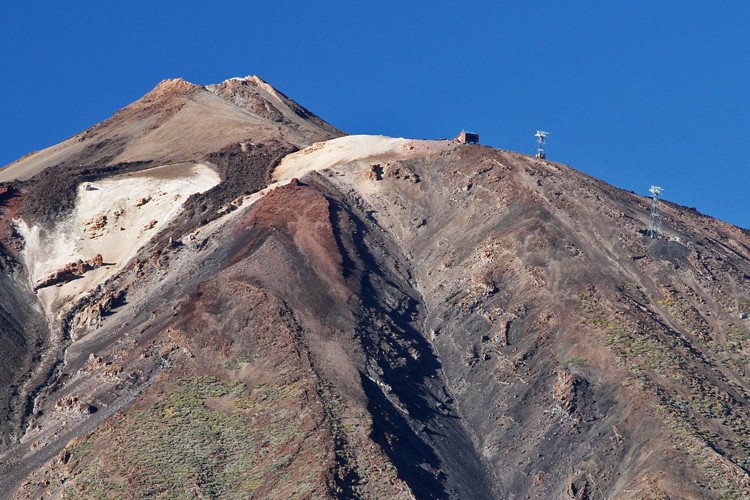
How to get there:
Access to the Cañada del Capricho. Once in the Teide National Park, you have to get to the parador and leave your car in the adjacent parking lot. Go to trail number 4 (Siete Cañadas). After several minutes you come to a track. Take a left until you can see the guardhouse of the park.
Access to the Roque of La Catedral. Pass the parador and park a little farther ahead, on the right-hand side. Go in the direction of the viewpoint, from where you can see the Cathedral, and take the path that leads directly to it.
By car:
TF-38 Boca Tauce-Chio: It’s only a 52 km drive and along the road, you can enjoy the Chinyero volcano responsible for Tenerife’s last volcanic eruption in 1909.
From the south, TF-21, via Arona and Vilaflor: It’s only a 47 km drive and you can make an en-route stop to visit the highest town in Spain.
From the north, TF-24 La Laguna-El Portillo, via La Esperanza. This is the longest route, between 55 and 64 km, but it’s also the ideal route to witness the phenomenon known as the ‘sea of clouds’.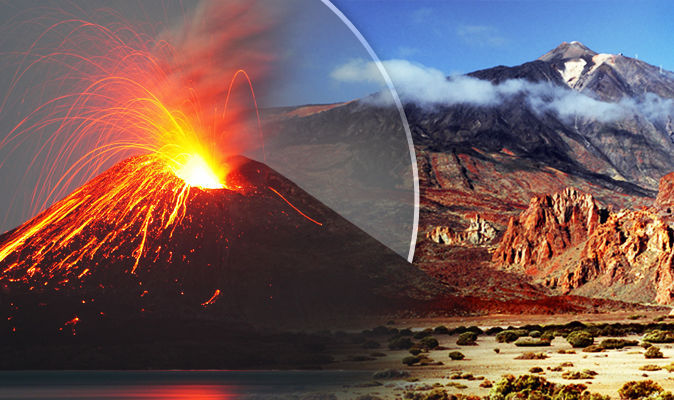
From the north, TF-21 La Orotava-Granadilla, via La Orotava: it’s only a 45 km drive. You can stop off and stroll around La Orotava, a lovely historic town, while enjoying the 17th and 18th century Canary Island architecture.
By bus:
348 line, from Puerto de la Cruz 342 line, from Adeje
Where to stay
Teide National Park:
- Refugio de Altavista. In the Altavista Refuge there are vending machines with the basics (water, coffee, soft drinks and chocolate). As expected, the prices are quite high (3 EUR per half a liter of water). Please note the water in the Teide refuge is NOT drinkable. Arrivals after 22:00 are not allowed. The bathrooms and kitchen open at 5:00 p.m. and the shared rooms at 7:00 p.m. and available till 10:00 p.m., while the check-out time is at 7:30 a.m. and it’s not possible to stay in the facilities later. And you should start your ascent to Teide no later than 9 a.m.
- Parador de las Cañadas del Teide: https://www.
parador.es/es/paradores/parador-de-las-canadas-del-teide
Vilaflor:
Vilaflor de Chasna is an essentially rural municipality located on the hillsides of southern Tenerife. It covers an area of 56.26 sq.km. and stands 1,500 m above sea level, making it one of the highest towns in Spain. It borders La Orotava, Arona, Granadilla de Abona, San Miguel and Adeje. Its scenic value is undeniable, and its economy relies significantly on potato crops, vineyards and almond groves thanks to the quality of its soils and the abundance of good water.
Ever since the 16th century, Vilaflor de Chasna has welcomed visitors who arrived along the Royal Road of Chasna drawn by the town’s proximity to Mount Teide and its pleasant climate, making it popular among botanists, scientists and also people with ailments looking to recover in this peaceful environment. After a long day of hiking, you might want to relax in the Hotel Spa Villalba.
What You Must Know About Teide National Park, Tenerife
Surreal scenes in Teide National Park © Kirsten Henton
Kirsten Henton
9 February 2017
You already know about the sun, the sea, and the sand, but have you explored Tenerife’s true gem at the heart of the island, Teide National Park? In a previous article, we looked at the top things to do in Tenerife, and called the park a must see that plays a vital role in local identity and pride, but now it’s time to dig a little deeper to share some of the wonderful things you can do up high when you visit Tenerife, no matter what time of year it is.
Teide National Park ticks many boxes: not only is it one of Spain’s oldest national parks, but it’s also the most visited with close to three million people exploring its near 19,000 hectares each year. It’s home to Spain’s highest peak (Mount Teide), one of the 12 Treasures of Spain, and a UNESCO World Heritage Site as of 2007, which simply cemented its status as one of the most revered attractions in the Canary Islands.
The park is as much a geologist’s dream as a statistician’s one, with so much to get excited about, from the snoozing giant volcano that is Mount Teide and its hardened lava flows, to the crazy rock formations and bizarre, alien-like landscape. The last major eruption occurred in the park in 1909, and as Mount Teide occasionally still puffs out the odd bit of steam and sulphur, it’s by no means dead and buried, merely biding its time; time that you can use to get out and about in the diverse scenery, be it above the clouds watching the sunset or treading amongst the robust, richly scented pine forests.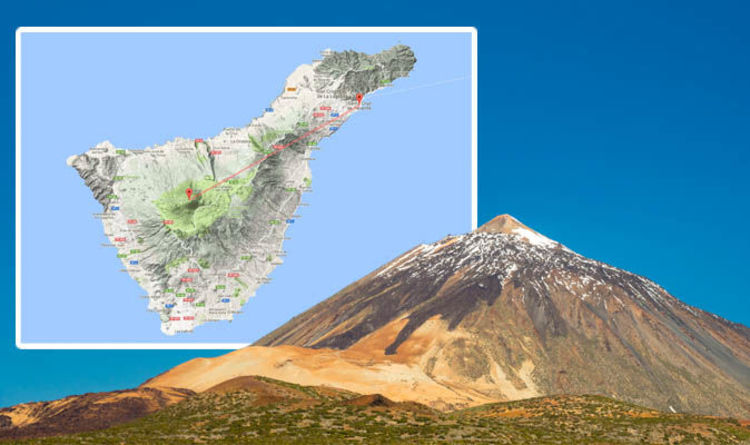
Walking in the national park, Tenerife | © Kirsten Henton
Tenerife is well stocked with companies offering tours, transport (public or private), and gear, which makes exploring the Teide National Park easier than ever before, no matter where you’re staying on the island. You’re likely to find a wider selection of facilities and operators in the south, as this is the more popular side for holidaymakers but you shouldn’t struggle if you’re based in the north.
An obvious choice but for a good reason, the cable car ride up the mountain gives you spectacular views without any effort, as its whisks you to the top in a mere eight-minute ascent. You emerge onto a platform with a loose-stone path that leads you round the curve of the mountain peak.
You can take the car up at any time between 9am and 4pm, while special evening tours can be booked through the park authority to make the most of the view at sunset, as you enjoy a glass of fizz and a local Canarian dinner (which are included).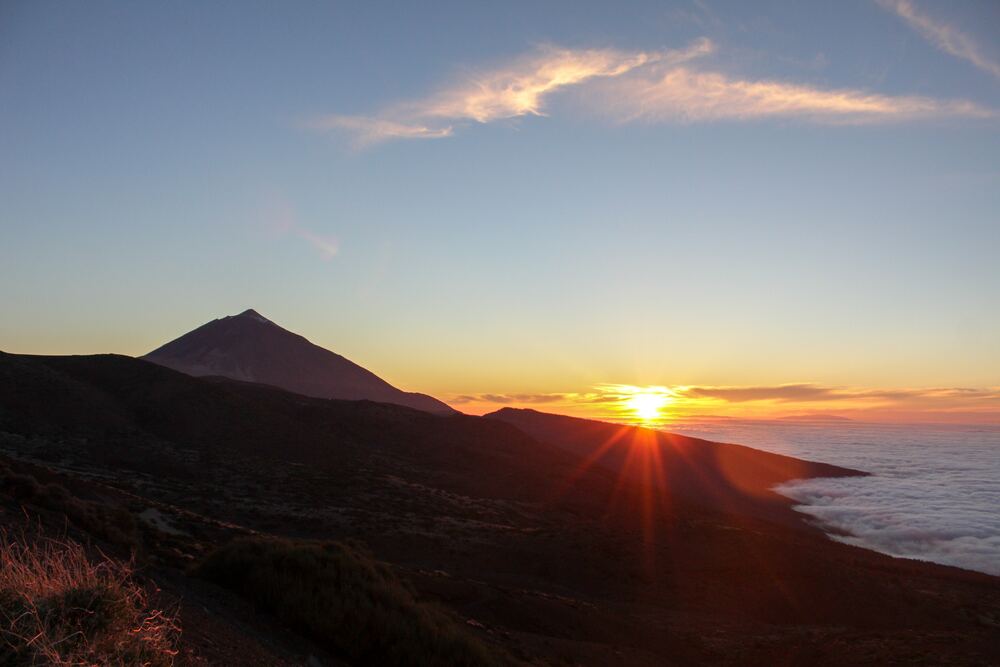
Pro tip: pack layers and good walking shoes! No matter how warm and sunny it appears, the higher you climb the colder it gets, and standing at over 3,000 metres, the peak of Mount Teide is one chilly place if you’re wearing only a t-shirt. Think jumpers, coat, gloves, a hat and, of course, your camera.
The cable car, Teide National Park | © Kirsten Henton
Tenerife is understandably proud of its trademark clear skies (the odd cloudy evening and full moon glare aside), and there’s nowhere better (in Europe, it’s said) to peer through a telescope and see sparkling stars, planets, and galaxies than in the national park, away from any light pollution. Various companies offer stargazing sessions in the national park, such as the official mountain guides and independent pros like Astro Amigos and Teide Astro.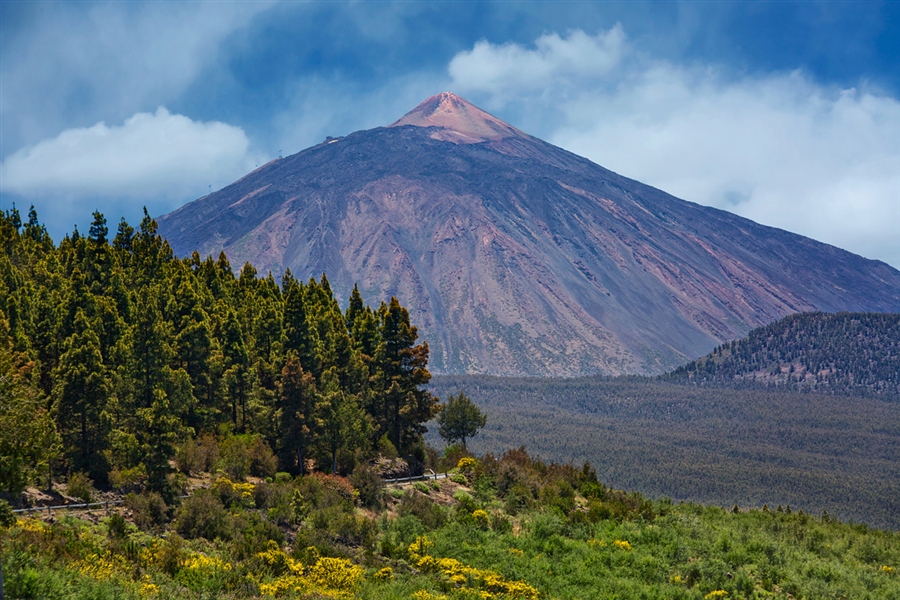
Sunset from Mount Teide | © Kirsten Henton
Whether you’re after a short stroll, easy hike or more intense climb, there are routes and trails for all abilities in Teide National Park. The landscape varies depending on your altitude as it gradually gets arid, less green, and more volcanic in nature the higher you go. For a delightful taste of what the park has to offer make sure you visit the crater at Samara; offering a gentle path passing lava flows with views across to neighbouring La Gomera. It’s a round route that takes around an hour and a half to two hours depending on your speed.
For something a little more challenging, why not tackle Mount Teide? It’s a demanding climb that takes roughly six hours, but the views are worth it and you can always hop on the cable car to get back down.
Lava flows with Mount Teide in the background | © Kirsten Henton
Los Roques de Garcia run from north to south along the main caldera in Teide National Park, some 2,000 metres above sea level yet roughly 1,700 metres below the top of Mount Teide.
Sculptures of Roques de Gracia | © El Coleccionista de Instantes Fotografía & Video/Flickr
Whether you’re familiar with the necessary run and jump of paragliding or a complete novice, taking a leap in Teide National Park is something you won’t forget. Paragliding is hugely popular in Tenerife with more than 40 launch sites and an ample selection of clubs offering the gear, advice, and guidance.
If it seems a little daunting, opt for a tandem jump which sees you strapped to an instructor who takes care of the business side of things while you simply enjoy the ride. A fabulous route is from Izana, in the northeast of the national park near the observatory, down to Puerto de la Cruz in the north of the island in 30 minutes.
Flying through the park | © Turismo de Tenerife
Tenerife enjoys stable weather with plenty of sunshine and warm temperatures that vary marginally from January to December. This makes it popular and accessible all year round, so deciding when to go comes down to precisely what type of weather you like. For the most sun and highest temperatures, aim for summer, while winter offers warm days and cool evenings, with plenty of sunshine, possibly even some snow up Mount Teide.
By Kirsten Henton
Give us feedback
Teide National Park, things that nobody will tell you
March 7, 2022Me With My Suitcase
Table of Contents
Climbing to the top of Teide Volcano is an adventure that everyone must experience at least once in their life. Its incredible lunar landscapes will really make you feel like you’re on another planet. But before you go…
What do you know about one of the most popular excursions in Tenerife? When I first went to the Teide National Park, I was not aware of many rules and regulations, which didn’t allow me to experience this adventure at its fullest.
* Disclaimer: This awesome, free article contains affiliate links. If you make a purchase after clicking one of these links, I earn a small commission at no extra cost to you. No pressure to use these links, but I really appreciate it when you do!
General Information about the Teide Volcano
- First of all, know that climbing to the top of the volcano must not be your number one priority. What I mean here is that the Teide Volcano covers a huge area and since each corner of the national park has a big value, even if you don’t take the cable car or hike up to the peak you’ll still be able to experience some of the most beautiful landscapes in Tenerife. Reaching the peak is not mandatory so don’t only focus on it; decide what is most convenient for you without being fixated on reaching the peak.
- Due to its volcanic and biological uniqueness, it was declared a national park in 1954, and it was given World Heritage Site status in 2007. In 2014, it became the first World Heritage Site to be designated as a ‘Starlight Destination’ owing to the quality of its sky for astronomical observation.
- Teide National Park receives an average of 3.5 million visitors per year. With this number of travellers each year, Teide National Park is one of the most visited national parks in all of Europe.
- There are a number of ways to get to Teide National Park in Tenerife. Among them driving your own car, taking a private bus tour excursion, or doing a quad biking experience are the best choices. You can bookTeide half day Tourand Teide Quad Biking tour from any of the tourist areas in Tenerife.
- There are two options for ascending Mount Teide: First, by cable car, travelling from the base station at an altitude of 2,356 m to the top station, known as La Rambleta, at 3,555 m.
The second option is to hike via Montaña Blanca (trail number 7). Given the limited time on the island, the cable car is the option that most visitors normally choose.
Read Also: 26 photos to make you fall in love with Tenerife
- With an altitude of 3,718-meter (12,198 ft.), Mount Teide is the highest point in Spain.
- If measured from the ocean floor, its height of 7,500 m (24,600 ft) makes Teide the third-highest volcano in the world.
- The trail that connects the Rambleta station (Top Station) to the peak of the volcano is number 10. It’s named “Telesforo Bravo,” and the hike takes about an hour. Around the Teide National Park, there are so many other hiking options than just number 10 to the summit. In fact, there are 37 officially designated trails in the park covering nearly 400 kilometres of ground.
- The volcano is still active, and the last eruption took place in November 1909. If you take the Teide Cable car to the Rambleta station, then you will even be able to see, in a few areas, a little bit of smoke coming out from the rocks. Now, I had already been to the Krafla Volcano in Iceland where the smoke emitting from the ground was spectacular. When I walked along the lava field there, I felt like I was in Dante’s “Inferno.” Because of that, I was not that impressed by seeing just a little bit of smoke here and there at the Teide Mount. But if it is your first time seeing a volcano, then undoubtedly you will enjoy it.
get your siam park admission ticket here
- At an altitude of 3,260 metres on the Teide Volcano there is a place to stay: The Altavista Refuge. It has three dormitory-style bedrooms with a total capacity of fifty-four people, along with toilets without a shower, it has a small kitchen, storage rooms, and a first aid room.
Stays are limited to one night with a prior online reservation. There isn’t a restaurant here, just some vending machines, so you’ll want to bring water and food. Staying at the Altavista Refuge at the Teide Volcano is definitely a great option for watching the sunrise and sunset from the summit. If you stay at Altavista, you’ll be able to get to the peak of Mount Teide before 9:00 am, and you can access the area without applying for a permit. Just be sure to leave the summit before 9:00 am. The Altavista Refuge is currently closed due to Covid.
- Mount Teide has the world’s largest cone-shaped shadow. One fascinating event that happens twice a day, at sunrise and sunset, around Mount Teide is the magnificent triangle-shaped shadow in the area around the mountain. To observe this spectacular occurrence, you will have to be on the highest point of the Island. The shadow cast is so huge extending hundreds of miles into the Atlantic Ocean.
This is said to be the world’s largest shadow over the sea.
- Mount Teide can be explored also during the night. Check out the excursions here. I highly recommend this evening with a difference in a unique setting!
- Although El Teide is the best known on the island, there are more than 200 volcanoes in Tenerife.
Teide Cable Car Information
- Children under 3 are not permitted to take the cable car.
- Cable car base station is at an altitude of 2,356 metres.
- Cable car upper station is at 3,555 metres, and it’s also known as La Rambleta station.
- Teide Peak is at 3,718 metres.
Visualizza questo post su Instagram
Un post condiviso da Me With My Suitcase (@mewithmysuitcase)
- The cable car ride from the base station to the Rambleta Station takes 7 minutes.
Meanwhile the Montaña Blanca trail is around 9 km long and it takes between 6 and 7 hours of hiking.
- Teide cable car doesn’t take you to the top of the crater; it takes you nearly to the summit, to the altitude of 3550m (11650 ft).
- People with heart problems, asthmatics, and pregnant women are not allowed to ascend by cable car up to 3550m because the high altitude is said to aggravate their health conditions. When I visited the Teide National Park with my father, we decided to stay at the Roques De Garcia area, and it was one of my most beautiful trekking experiences in Tenerife.
- Persons of reduced mobility or special needs may not ascend by cable car: if the service is interrupted unexpectedly, people at the top station will be required to descend by foot along very steep terrain.
- The Teide cable car can be closed without any notice in the case of strong wind or heavy snow on the summit.
If you want to go up the volcano by cable car, I recommend booking your ticket in advance here.
Rules and Regulations at the Teide Volcano
- Only one hour stay is allowed at the Rambleta Station. Now, never ever forget this point because if you exceed this defined time, you may be asked to pay to descend again. Considering that the cable car ticket doesn’t have a small priced, this could be very annoying.
- Drone flying is not allowed in the whole area of the Teide National Park. Professionals like film makers, television, and people linked to video and photographic activities must obtain authorisation at least 15 working days prior to the start of filming. In addition to the application properly filled in and signed, they also need to add a photocopy of the ID, passport, or resident card of the person applying for the permit.
- Once you are at the Rambleta station, if you want to reach the top of Teide volcano, you’ll have to complete the remaining 530 feet or so on foot.
Remember that if you want to hike up to the crater you need special permission which should be obtained online ahead of time from the Reservas de Parques Nacionales website. The permit to climb to the peak of Teide is FREE, meaning there is no cost to be paid, but the registration with date and time is mandatory. The permit cannot be issued on site for any reason. Also know that the number of daily permits to access Teide crater is limited and it is necessary to apply for it at least two months in advance if you want to make sure to obtain one.
- For conservation and security reasons, access to the crater (trail number 10, known as the Telesforo Bravo path) is restricted to a maximum of 200 people per day. Out of the 200 online permits that the National Park provides each day, some are reserved for the National Park’s official guides.
- In order to better control the groups using the cable car and the trail NUMBER 10, the day has been split into two-hour periods in which the trail can be used.
Visitors must choose the period in which they will use the trail. These periods are:
– From 9:00 to 11:00 AM.
– From 11:00 AM to 1:00 PM.
– From 1:00 to 3:00 PM.
– From 3:00 to 5:00 PM (if you choose this period, keep in mind that the last cabins of the Teide Cableway come down around 4:30 PM and sometimes earlier, especially in winter).
- If you have the permit to reach the crater, the maximum amount of time for being at the top (between the upper station, the trail and the peak) is 2 hours.
- During your visit to the Teide National Park, you are asked to remain in the demarcated areas. In case of emergency, Teide National Park rescues with a helicopter. If you are found in the indicated trail zone, then the assistance will be given free of charge. But if you are out of the demarcated areas then you will be asked to pay for the service. Which, I assure, doesn’t come cheap.
- Taking home a piece of Teide volcanic rock could actually be constituted as an environmental crime since it is considered damaging to the island’s beautiful landscape, so don’t be tempted!
What you don’t want to forget for exploring the Teide Volcano
- Wear sunglasses to protect yourself from strong sunlight in both winter and summer.
Luminosity at such an altitude is elevated.
- Wear suitable footwear for walking over rocky terrain. The surface of the upper station trails is irregular.
- Wear warm clothing. Although it may be very sunny at the beach, weather at an altitude of 3 555 m may surprise you. We recommend carrying a jacket.
- Wear a hat.
- Use sunblock to prevent sunburn.
- Don’t forget to bring enough water.
- Take some food with you.
Have any other questions about the Tenerife Volcano, Mount Teide hiking, or want to share your own experiences? Please do so in the comments below!
Prev Post
Cosmoprof Worldwide Bologna
February 28, 2022
Next Post
Marrakesh, Accommodation Review, Riad Star + VIDEO
March 14, 2022
This website uses cookies to improve your experience.
Mount Teide – the highest mountain in Spain
Author: Ksenia Alekseeva
in Travel Europe
12/27/2017
comments 2
6656 Views
The Teide volcano is the main symbol of the island of Tenerife. The majestically towering peak of the volcano can be seen from anywhere on the island. During our third trip to the Canary Islands, we decided to go to the foot of the volcano. We tell you about our experiences.
Brief information about the Teide volcano
First, I would like to tell you a little about the Teide volcano, which holds the record in many ways.
- Teide is 3,718 meters high, making it the highest point in Spain and the islands in the Atlantic Ocean.
- Teide is an active volcano that last erupted in 1909.
- The first Europeans to climb the Teide were the British in the middle of the 17th century.
- The volcano and its surroundings form the 19,000-hectare Teide National Park, which is under the protection of UNESCO.
- The volcano is visited annually by 3 million tourists.
- The average temperature in the vicinity of the volcano during the year is about +4 °С in January and +19 °С in August.
- The Teide National Park contains, among others, endemic plant and animal species.
Teide was once a sacred mountain for the Guanches who inhabited the Canary Islands. There were many legends around the volcano, as well as around Mount Olympus in ancient Greece. According to the beliefs of the Guanches, Teide held the sky, and was home to the evil demon Guayot. The locals were convinced of the strength of the volcano by the fact that Teide kept the rains in the north of the island and prevented them from flooding the sunny south.
Teide’s bizarre rock formations and landscapes attract screenwriters from all over the world. The lunar landscapes of Teide have become a platform for many films – “Clash of the Titans”, “Doctor Who”, “Fast and Furious 6”.
About our trip to the Teide volcano
You can go to the Teide volcano from the south of the island of Tenerife on your own by bus or in a rented car, or as part of an organized excursion. There were four of us, so it was decided to book a car for 2 days. We rented an Opel Mokka car.
We booked 1 day to visit Teide, the town of La Orotava and a large city in the north of the island of Puerto de la Cruz. The road to Teide by car on the TF-38 road took about 1 hour. There is also a straight road TF-51, but it winds a lot. At the entrance to the Teide, we stopped at several viewing platforms.
Landscapes were rapidly changing around us – it would seem that we had just been on the ocean shore, and now we are driving through a dense strip of pines, and later – through a desert with rare heather bushes and bizarrely shaped stones.
After passing several viewing platforms, we arrived at the departure station of the funicular to Peak Teide, located at an altitude of 2,356 meters. This is where the tour buses arrive. Already at this altitude it becomes difficult to breathe, and the air is thinner. From a height of 2,356 meters, you can climb almost to the top of the Teide – to a height of 3,555 meters. On the peak itself, which is still 200 meters up, small groups are allowed only with prior permission. The funicular ride lasts 8 minutes and costs 27 Euros round trip.
Hikers can climb up to 3,555 meters on foot – there are several trails, but the climb will take at least 5 hours. They say that in clear weather, from the top of the volcano, you can see almost all the Canary Islands, except for the island of Fuerteventura and a few other islands.
We decided not to climb the very top of the volcano, because not everyone in our team was comfortable from the height difference.
We also couldn’t resist taking a photo against this background.
Not far from one of the observation decks there is a cafe with souvenirs and a toilet. However, I do not recommend buying souvenirs in it: you can buy all the same crafts made of volcanic stone in any souvenir shop on the island, but at a price of 2 or even 3 times less. We learned this from our own experience when we bought a souvenir calendar in the Teide shop for 6.5 Euros, which cost only 2.5 Euros elsewhere.
There is a large observatory in the foothills of the Teide. The observatory appeared here for a reason – the fact is that the Canary Islands are one of the best places in the world for observing the stars and the Milky Way.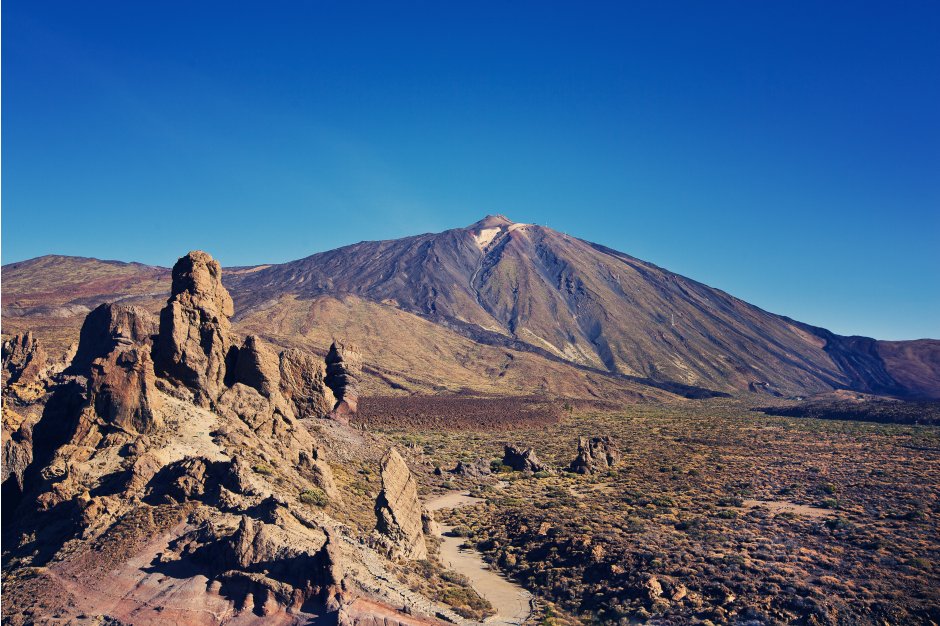
Our way back passed through the famous Martian landscapes – the terrain as if from another planet, literally scorched by the scorching sun. There is no vegetation here at all – there are stones, rocks and yellow earth all around.
After that, we went to lunch in the cute town of La Orotava, which I will tell you about in one of the following posts. The path passed through a thick strip of fog.
Whether or not you should visit Teide is up to you. I would say that such a trip will be interesting for lovers of hiking, mountains and beautiful selfies. A trip to the Teide will pleasantly diversify your leisure time in Tenerife – it’s not all the time to lie on the beach, right? Plus, the views are worth it!
A few practical tips for those who have gathered on the Teide
- When traveling to the volcano, all guides recommend stocking up with warm clothes – strong wind blows at altitude, and walking in shorts is uncomfortable.
Therefore, tourists here go in jeans and warm jackets, regardless of the time of year.
- It is best to rent a car in advance via the Internet (the season in Tenerife lasts all year round, and there are always a lot of tourists!).
- The Teide is served by a TITSA intercity bus. From the south of the island (Playa de las Americas with a stop in Los Cristianos) – bus number 342, departure at 09:15, return flight at 15:30. From the north of the island (Puerto de la Cruz) – bus number 348, departure at 09:15, return flight at 16:00.
- If you don’t want to make your own travel itinerary on the Teide, book an interesting individual excursion with a guide in Russian who will think of everything for you. Night excursions on Teide are very popular, when the volcano can be viewed in the light of the stars.
- If you feel bad on winding roads (serpentine), I recommend taking pills for motion sickness beforehand.
You may also be interested in
💰 Hotellook — An honest comparison of prices and discounts for hotels and apartments in 50 booking systems (Booking, Agoda, Ostrovok.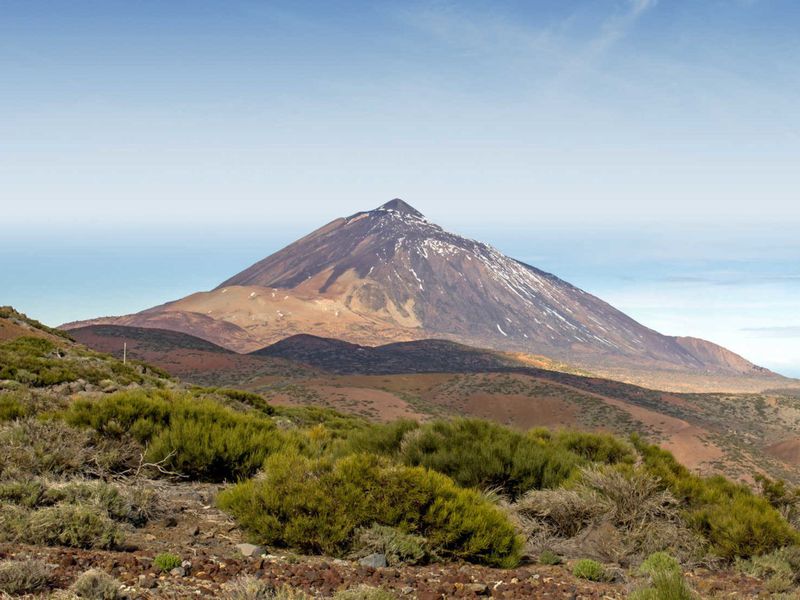
✈ Search for the cheapest air tickets without markups from reliable agencies of official dealers of Aeroflot, S7, Ural Airlines and all famous airlines in the world.
📸 Book educational excursions in any city of the world in Russian with the best guides.
Mount Teide: video, famous tourist places, Satellite map, photos – Canary Islands
• Canary Islands
• Spain
Search:
Mountains, caves, canyons
Spain
• all objects
Teide is a volcano in Tenerife, a major tourist attraction. The first national park in Spain is located on the slopes of the mountain, a cable car leads to the crater area
Tourism news:
Tours, resorts •
Visas and Passports •
Developments
Place the video and map on your website
- Satellite map
- Full screen
- Photos
- Flights
Detailed interactive map Mount Teide
Nearby you can see
|
Canary Islands Holidays in the Canary Islands – a warm sea, golden sand, luxury hotels. |
|
|
Santa Cruz de Tenerife Santa Cruz de Tenerife, the capital of the island of Tenerife, attracts with its special “Canarian” flavor, first-class beaches and excellent shopping |
|
|
Gran Canaria According to tourists, this island is Europe in miniature, thanks to the variety of its landscapes. |
|
|
Hierro Holidays on this small island are especially good for lovers of peace and quiet. |
|
|
Caleta de Fuste Caleta de Fuste or El Castillo is the third largest resort in Fuerteventura. Excellent conditions for a beach holiday, developed infrastructure, excellent golf course |
|
|
Coralegio |
|
|
La Palma La Palma hotels are one of the coziest and most comfortable in the Canary Islands. |
|
|
Lanzarote The island is famous for the Cesar Manrique Museum, the Timanfaya Reserve, the Cueva De los Verdes caves and the Cactus Museum. |
|
|
Los Cristianos |
|
|
Playa del Inglés |
|
|
Teresitas Beach |
|
|
Puerto de Morgan |
|
|
Puerto del Carmen |
|
|
Puerto de la Cruz |
|
|
Tenerife The “Island of Eternal Spring” Tenerife, with its amazing landscape and most favorable climate, enjoys stunning popularity among tourists from all over the world |
|
|
Tejeda |
|
|
Fuerteventura The island of Fuerteventura with beautiful long beaches of white and golden sand is an ideal holiday destination for lovers of peace, quiet and solitude |
|
|
Homer Travelers arriving on this island are always fascinated by its exotic nature. |
|
|
Diving, Homer The small island of Gomera has a wide range of excellent, world-class dive sites offering dives of all levels of difficulty |
|
|
Jandia Playa |
|
|
Orotava Valley The verdant Oratava Valley in the north of Tenerife, famous for its vineyards and banana groves, is one of the most popular tourist destinations in Spain |
|
|
Loro park |
|
|
Mirador del Rio |
|
|
Playa de las Americas |
|
|
Mask Gorge |
|
|
Jameos del Agua |
Spain
map • all objects
Spain • News
Spain • 2014-01-31
Business Tourism in Spain.
…
Spain • 2013-12-03
Spain has published the best agritourism destinations …
Spain • 2013-11-11
The ski season in the Pyrenees starts in mid-December …
Spain • 2013-11-08
A hotel in Granada has published a list of its famous guests …
Spain • 2013-11-08
| Home. Mountains, peaks, peaks, ascents // Mountains, peaks, peaks // Teide
The height of the mountain is quite accurately measured and is three thousand seven hundred and eighteen meters, or twelve thousand one hundred and ninety-eight feet. |
||
| Information about sources and authors of site materials | Legal information
Mountains and ranges of the world, peaks, peaks, ascents |
©2010-2022 ®¡™! | |||||
The highest mountain in Spain, the Colossus of the Canaries
La the highest mountain in Spain Curiously, it is located outside the Iberian Peninsula. It’s about Teide , located in the Canary Islands Tenerife , colossus 3718 meters altitude. It forms a natural park declared a World Heritage Site.
True, the island peak is followed by Mulhacen at a short distance, with its 3478 meters above sea level. Located in the Sierra Nevada, it is the highest mountain in the Latin American peninsula. And then we have Aneto , in the Aragonese Pyrenees and from 3408. To find the fourth highest mountain spur, you need to go back to the Sierra Nevada, because it is Peak Veleta , which already drops to 3398 meters above sea level . But in this article, we will talk with you about the highest mountain in Spain.
Index
- 1 A little story Teide
- 2 Mythology around Teide
- 3 Flora and the Fauna of the highest mountain of Spain
- 4 Case
- 4.
1 Other routes on Teide
- 4.
a little history of Taida from the stages of the formation of Teide
The first thing we have to tell you is that Teide is not a mountain in the strict sense, but a volcano . About fifteen million years ago, there was another one on the island of Tenerife, even larger than the present one, but it disappeared. This circumstance could be caused by its separation and subsequent fall into the sea or the collapse of the entire territory, causing its flooding.
These are the two hypotheses that are being processed, but using either of them Cañadas del Teide . Subsequently, new eruptions gave rise to the current mountain. The resulting territory is composed of basalt-type materials, although salic materials predominate in its upper layers. There are also deposits of pyroclastic pumice.
This geological composition is largely responsible for the fact that the Teide, when there is no snow on it, changes its color from afar. At sunset, it is reddish, and the rest of the day it is beige, gray and even bluish.
Mythology around the Teide
Teide shadow phenomenon
Like other great mountains of the world, the Canaries have been a source of mythological beliefs since ancient times. For the Guanches, it was holy mountain from which, by the way, obsidian was obtained. According to their beliefs, Guayota , the spirit of Evil, lived inside the volcano.
For this reason, many remains of local artifacts have been found in its caves. The Guanches left them as offerings to counteract the power of the aforementioned spirit. However, other theories suggest that the mountain was considered by them rather axis of the world . This is the name in mythology of places that are considered the axis of the world or the points of confluence of different levels of the universe.
The Canarian colossus also fascinated the authors of classical antiquity. Greek Herodotus I called him Atlas and Roman Pliny the Elder I spoke of the snows Ninguaria , the name given to the island of Tenerife. Already in the Renaissance, many wanted to see the remains of the legendary Atlantis in the Canary Islands and Teide as the mountain that Poseidon gave to Atlas.
Already in the XNUMXth century, the highest mountain in Spain began to be considered using scientific criteria. However, the authors of Julio Verne continued to invent stories about him. In any case, the first documented ascent to the summit belongs to the Italians. Prosper Casola y Leonardo Torreni B 1588.
On the other hand, if we are talking about curiosities, we must refer to shadow phenomenon . It was first described by other climbers who climbed to the top – the British Philips Ward and John Weber , which they did around 1650. It consists of the Teide, which casts the world’s largest shadow projected onto the sea. It is so large that it partially covers the island Gran Canaria or one La Gomera , depending on the time of day. As if this is not enough, although the mountain is not quite triangular, but the shadow from it. In any case, the truth is that this phenomenon is unique in the world.
Flora and fauna of the highest mountain in Spain
Red Tajinaste in the highest mountain in Spain
The entire Teide National Park is one of the most outstanding natural spaces in the world due to the huge number of endemic species of fauna and flora that has. As you know, endemism is a subspecies that exists in only one region of the planet.
As for them, there are about fifty-eight in the flora. They highlight Violet Teide , el
Silver Thistle , el
red tagine , el
guanche rosebush or rabbit grass and several species of moss and borriz. Some of them are endangered. For this reason, the authorities of the Canary Islands are taking various actions to preserve them.
In terms of fauna, about seventy species are also endemic to the area. They are represented by eared bat y el
lizard Tizon . But others introduced later are also very numerous, such as the Mauritanian hedgehog, the rabbit and the mouflon. It is the latter that poses a threat to the aforementioned rabbit grass, as it is included in its diet. Along with them, many other species live in the park, such as the hoopoe or long-eared owl among birds, the common perenken among lizards, or the wild snowcat among mammals.
Climbing the Teide
Teide Cable Car
Curiously, despite its height, climbing Spain’s highest mountain is not difficult. In fact, there is a cable car here that reaches a height of 3555 meters. Then you must follow the number ten hiking trail, also known as Telesforo Bravo trail which will take you straight to the crater of the volcano.
This route seems easy as it is only about six hundred and fifty meters long, but it goes up. The fall is 163 meters and takes about forty minutes. However, it is this difference in altitude and the lack of oxygen that make climbing difficult. However, if you consider yourself an experienced climber, you can walk the route on foot from the base. In this case, the route follows White Mountain Trail .
Any option is good. The choice of one or the other depends on your abilities. Another thing is the permissions problem . You will need one to get to the top, as access is limited to two hundred people a day. In addition, there is a two-month waiting list. In other words, if you plan to climb in September, for example, you will have to apply for permission in July.
You have two options to request it. The first is through the National Parks website. Instead, the second one goes through a guided tour. For the latter, you will only need to hire an accredited company. She will take care of the permissions.
However, if you spend the night at Altavista shelter , which we’ll talk about later, and you get up before 9 am, you won’t need a permit to climb the Teide.
Other routes on the Teide
Altavista shelter on the Teide
On the other hand, other routes can be reached from the cable car. As an example, we will describe two of them. The first number is eleven or in terms of fortress . It heads northwest and shows the most perfect slope of the volcanic cone. This one is on the left and on the other side you can see Montaña Blanca and remnants of old castings. But most importantly, when you get to the observation deck that gave it its name, you will have a breathtaking view of the entire northern part of the island of Tenerife. You will also see Orotava Valley and chord Anaga Massif .
Second route number twelve or from the observation deck of Pico Viejo . It will take you to the western slope of Mount Pylon, from where you can enjoy an impressive view of the crater Mount Chahorra (or Pico Viejo) eight hundred meters in diameter. Also in this case you will appreciate the southern slope of the island, from Mount Guajara , los
Cliffs of Garcia and even on the plain impressive Flowery pine forest y La Gomera .
Finally, on route number seven, you have Altavista Shelter , which we have already quoted to you. It is the only one on the Teide and consists of two buildings. It has three shared bedrooms that can accommodate fifty-four people. The beds are equipped with matching clothes so you don’t need a sleeping bag.
It also offers you other amenities such as living room, dining room, kitchen and even an infirmary. The whole complex is equipped with heating and toilets, although it does not have a shower.
The shelter was built in 1892, although it was completely renovated in 2007. It also has hot drinks, water and soft drinks, but you will need to bring your own groceries. However, as we told you, he has a kitchen to heat him up. The stay is limited to one night. But you will enjoy a beautiful view of the Canary sky.
In conclusion, we have told you about the highest mountain in Spain . We’ve also explained everything you need to know to climb to the top. However, since you are on the island of Tenerife, we would like to advise you to visit the other attractions it has to offer. Among them are the capital, Santa Cruz , but also the tourist Puerto de la Cruz , the rural Masca , the Parque del Teno and the historical San Cristobal de la Laguna y Orotava . Don’t you want to get to know this colossus of rock and the cities that surround it?
Want to book a guide?
Teide – Teide – www.no-regime.com
This 3D panoramic view of Mount Teide was created using SRTM data (160% height).
Teide or Mount Teide (Spanish: El Teide, Pico del Teide , pronounced [ˈpiko ðel ˈtejðe], “Teide Peak”) is a volcano in Tenerife, in the Canary Islands. Its peak (3718 m (12 198 feet)) is the highest point in Spain and the highest point above sea level in the islands of the Atlantic Ocean.
Measured from the ocean floor, its 7,500 m (24,600 ft) height makes Teide the world’s fourth tallest volcano, and is described by UNESCO and NASA as the Earth’s third tallest volcanic structure. However, since Teide was formed only 170,000 years ago due to volcanic activity after a catastrophic landslide, Teide’s base is actually located in the crater of Las Cañadas (the remains of an older, eroded, extinct volcano) at an altitude of about 2190 m (7 190 m). feet) above sea level. The height of Teide above sea level makes Tenerife the tenth highest island in the world. Teide is an active volcano: its last eruption occurred in 1909 from the El Chinyero vent in the northwest of the Santiago Fault. The United Nations Committee on Disaster Mitigation named Teide a Decade Volcano due to its history of destructive eruptions and proximity to several major cities, of which Garachico, Icod de los Vinos and Puerto de la Cruz are the closest. Teide, Pico Viejo and Montaña Blanca form the central volcanic complex of Tenerife.
The volcano and its surroundings make up the Teide National Park, which covers an area of 18,900 hectares (47,000 acres) and was inscribed on the UNESCO World Heritage List in 2007. Teide is the most visited natural wonder of Spain, the most visited national park in Spain. and Europe and – by 2015 – the eighth most visited in the world, with about 3 million visitors annually. In 2016, it was visited by 4,079,823 visitors and tourists, which was a historical record. The Teide Observatory, a major international astronomical observatory, is located on the slopes of the mountain.
CONTENT
- 1 Name and legends
-
2 Formation
- 2.
1 Stage one
- 2.2 Second and third stages
- 2.3 Fourth stage
- 2.4 Fifth stage
- 2.
- 3 Historical eruptions
- 4 Possible eruptions
- 5 major ascents
- 6 Flora and fauna
- 7 Shade of Teide
- 8 Scientific use
- 9 Access
- 10 Astronomical Observatory
- 11 Symbol
- 12 Mountain of the Moon
- 13 See also
- 14 Notes
- 15 Links
- 16 External links
Name and legends
Before the Spanish colonization of Tenerife in 1496, the indigenous Guanches named a powerful figure who lived in a volcano that brought light, power and the sun. El Pico del Teide is the modern Spanish name.
Teide was a sacred mountain for the indigenous Guanches, so it was considered a mythological mountain, like Mount Olympus for the ancient Greeks. According to legend, Guayota (the devil) kidnapped Magek (the god of light and sun) and imprisoned him inside a volcano, plunging the world into darkness. The Guanches asked their supreme god Achaman for mercy, so Achaman fought Guayota, freed Magek from the bowels of the mountain and plugged the crater with Guaiota. Guayota is said to have remained locked inside the Teide ever since. Going to the Teide during an eruption, the Guanches used to light fires to scare Guayota. Guayota is often represented as a black dog accompanied by his host of demons (Tibicenas).
The Guanches also believed that Teide supports the sky. Many caches found in the mountains contain the remains of stone tools and pottery. They have been interpreted as ritual deposits to counter the influence of evil spirits, such as those made by the Kabylie Berbers. The Guanches believed that the mountain was the place where the forces of evil and the most evil figure, Guayota, lived.
Guayota has features similar to other powerful deities that inhabit volcanoes, such as the goddess Pele from Hawaiian mythology, who lives in the Kilauea volcano and is believed by the native Hawaiians to be responsible for the volcano’s eruptions. The same was true for the ancient Greeks and Romans, who believed that Vulcano and Mount Etna were the chimneys of the foundry of the fire god Hephaestus (Vulcan in Latin).
In 1492, when Christopher Columbus arrived on the island of Tenerife, his team claimed to have seen flames emanating from the island’s highest mountain (Teide).
Formation
Synthetic aperture radar image of Tenerife with marked volcanic masses.
Summary diagram of the formation of Tenerife to the present volcano Teide
The stratovolcano Teide and Pico Viejo (Old Peak, although it is actually younger than Teide) are the most recent centers of activity on the volcanic island of Tenerife, which is the largest (2058 km 2 or 795 sq mi) and the highest (3715 m or 12,188 ft) island in the Canaries. It has a complex volcanic history. The formation of the island and the development of the active volcano Teide took place in five stages, shown in the diagram on the right.
Phase one
Like the other Canary Islands and the islands of the volcanic ocean in general, Tenerife was built as a result of the formation of three large shield volcanoes that formed in a relatively short period. This early shield volcanism formed much of the emerging part of Tenerife. Shield volcanoes date from the Miocene and early Pliocene and are preserved in three isolated and deeply eroded massifs: Anaga (to the northeast), Teno (to the northwest), and Roque del Conde (to the south). Obviously, each shield was built in less than three million years, and the entire island in about eight million years.
Second and third stages
The initial juvenile stage was followed by a period of eruptive dormancy and erosion lasting 2–3 million years. This shutdown is typical of the Canary Islands; La Gomera, for example, is now at this stage. After this period of calm, volcanic activity concentrated in two large structures: the central volcano Las Cañadas and the Anaga massif. The Las Cañadas volcano formed over the Miocene shield volcanoes and may have been 40 km (25 mi) in diameter and 4,500 m (14,800 ft) high.
Fourth stage
About 160-220 thousand years ago, the top of Las Cañadas I volcano collapsed, forming the Las Cañadas (Ucanca) caldera. Later, a new stratovolcano Las Cañadas II formed in the vicinity of Guajara, which then catastrophically collapsed. Another volcano, Las Cañadas III, formed in the sector of the Diego Hernandez caldera. All Las Cañadas volcanoes have reached maximum heights similar to that of Teide (sometimes referred to as Las Cañadas IV volcano).
There are two theories for the formation of a 16 km × 9 calderakm (9.9 × 5.6 mi). The first states that the depression is the result of a vertical volcanic collapse caused by the devastation of shallow magma chambers at approximately sea level below Las Cañadas volcano after high-volume explosive eruptions. A second theory is that the caldera was formed by a series of lateral gravity collapses similar to those described in Hawaii. Evidence for the latter theory has been found both in land-based observations and marine geology studies.
Fifth stage
Approximately 160,000 years ago and to this day, the Teide and Pico Viejo stratovolcanoes formed in the Las Cañadas caldera.
Historic eruptions
The last eruption of Teide occurred in 1909 from the mouth of El Chinyero on the Santiago Ridge. Historical volcanic activity on the island is associated with the Santiago vents or northwest rift (Boca Cangrejo in 1492, Montañas Negras in 1706, Narices del Teide or Chajorra in 1798 and El Chinyero in 1909) and the Dorsal or northeastern fault of the Cordillera (Fasnia). in 1704, Siete Fuentes and Arafo in 1705). The eruption of Montañas Negras in 1706 destroyed the city and main port of Garachico, as well as several small villages.
Historical activity related to the Teide and Pico Viejo stratovolcanoes took place in 1798 in the region of Narices del Teide on the western slope of Pico Viejo. Eruptive material from Pico Viejo, Montaña Teide and Montaña Blanca partially fills the Las Cañadas caldera. The last explosive eruption involving the central volcanic center occurred on Montaña Blanca about 2,000 years ago. The last eruption in the Las Cañadas caldera occurred in 1798 from Naris del Teide or Chahorra (Teide’s Nostrils) on the western slope of Pico Viejo. The eruption was predominantly Strombolian in style and most of the lava was aa. This lava is visible along the road Vilaflor – Chio.
Christopher Columbus reported seeing “a great fire in the Orotava Valley” when he sailed past Tenerife on his voyage to discover the New World in 1492. This has been interpreted as an indication that he witnessed an eruption there. Radiometric dating of possible lavas shows that at 149There were no eruptions in the Orotava valley in 2008, but it still came from the Boca Cangrejo vent.
The last eruption at the summit of Teide occurred around 850 AD, and as a result of this eruption, the “Lava Negroes” or “Black Lavas” were formed, which cover most of the slopes of the volcano.
About 150,000 years ago there was a much larger explosive eruption, probably with a volcanic explosiveness index of 5 . It created the Las Cañadas caldera, a large caldera about 2,000 meters above sea level, about 16 km (9.9 miles) from east to west and 9.9 miles. km (5.6 miles) from north to south. At Guajara, on the south side of the structure, the interior walls rise in sheer cliffs from 2,100 to 2,715 m (6,890 to 8,907 ft). The 3,715 m (12,188 ft) summit of Teide itself and its sister stratovolcano, Pico Viejo (3,134 m (10,282 ft)) are located in the northern half of the caldera and were formed by eruptions that occurred after this prehistoric explosion.
Possible eruptions
Future eruptions may include pyroclastic flows and surges like those at Mount Pele, Merapi, Vesuvius, Etna, the Soufrière Hills, Mount Unzen and elsewhere. In 2003, an increase in the seismic activity of the volcano was observed, and a rift opened on the northeastern slope. No eruptive activity has occurred, but some material, possibly liquid, has been introduced into the building and is estimated to be ~10 11 m 3 . Such activity may indicate that magma is rising into the building, but is not always a precursor to an eruption.
In addition, Teide is considered structurally unstable, and its northern flank has a characteristic bulge. There are several small, active fumaroles at the top of the volcano, emitting sulfur dioxide and other gases, including low levels of hydrogen sulfide.
A 2006 scientific assessment published in the journal Eos notes that “Over the past 30,000 years, there have been only four to six eruptions per millennium, dominated (70%) by very low-hazard basalt eruptions.” . The authors further noted that “the recent record of eruptions, combined with available petrological and radiometric data, provides a rather optimistic view of the main volcanic hazards associated with Teide and its rift zones, presenting only very localized threats to Tenerife’s one million inhabitants and 4.5 million visitors.” Teide National Park every year. However, another study conducted in 2009year, came to the conclusion that Teide is likely to erupt violently in the future, and that its structure is similar to Vesuvius and Etna. Thus, the extent of the danger Teide poses to society remains a matter of debate.
Main climbs
In a 1626 publication, Sir Edmund Scorey, who probably stayed on the island in the first decades of the 17th century, gives a description of the Teide, in which he notes the suitable routes to the summit and the consequences of its considerable height for travelers., indicating that before the 17th century, the volcano could be reached by different routes. In 1715, the English traveler J. Edens and his group made an ascent and reported their observations in the journal of the Royal Society in London.
After the Age of Enlightenment, on most expeditions to East Africa and the Pacific, the Teide was one of the most valuable targets. The expedition of Lord George Macartney, George Staunton and John Barrow in 1792 almost ended in tragedy, as a heavy snowstorm and rain fell on them, and they could not reach the summit of the Teide, barely passing Montaña Blanca.
The German scientist Alexander von Humboldt stopped in Tenerife during his trip to South America in 1799 and climbed the Teide with his companion Aimé Bonpland and some local guides.
During an expedition to Mount Kilimanjaro, the German adventurer Hans Heinrich Josef Meyer visited Teide in 1894 to observe the ice situation on the volcano. He described these two mountains as “two kings, one of which rises in the ocean, and the other in the desert and steppes.”
Most recently, in November 2017, Hema Hassen-Bey became the first wheelchair Paralympic athlete in the world to reach a height of 3,000 meters with just a movement of her arms. Initially, Hema wanted to reach the summit of Teide, but due to weather conditions, she was unable to complete this task.
Flora and fauna
Echium wildpretii in Tenerife
Lava flows down the slopes of the Teide to a very thin but rich in nutrients and minerals soil that supports a variety of plant species. The vascular flora consists of 168 plant species, 33 of which are endemic to Tenerife.
Forests of Canary pine ( Pinus canariensis ) with Canary Islands juniper ( Juniperus cedrus ) occur at altitudes between 1000 and 2100 meters (3300–6900 ft), covering the middle slopes of the volcano and reaching the alpine tree line 1,000 m (3,300 ft) below. than those of continental mountains at the same latitudes. In the Las Cañadas caldera and at higher altitudes, plant species endemic to the Teide National Park include: the Teide white broom ( Spartocytisus supranubius ) with white flowers; Descurainia bourgaeana , yellow-flowered shrub cruciferous plant; Canarian clam ( Erysimum scoparium ) with purple flowers; and Baglos Teide ( Echium wildpretii ), whose red flowers form a pyramid up to 3 m (9.8 ft) high. Teide chamomile ( Argyranthemum teneriffae ) can be found at altitudes close to 3,600 m (11,800 ft) above sea level, and Teide violets ( Viola cheiranthifolia ) can be found right at the top, making it the most flowering plant in Spain.
These plants are adapted to the harsh environment of the volcano, such as high altitude, intense sunlight, extreme temperature changes and lack of moisture. Adaptations include hemispherical shapes, downy or waxy cover, reduced open leaf area, and high flower production. Flowering occurs in late spring or early summer, in May-June.
South Tenerife lizard ( Gallotia galloti galloti )
Teide National Park is home to a large number of invertebrate species, over 40% of which are endemic and 70 of which are found only in the national park. The invertebrate fauna includes spiders, beetles, dipterans, semimembranos, and hymenoptera.
In contrast, the Teide National Park has only a limited variety of vertebrate fauna. Ten species of birds nest here, including the blue finch ( Fringilla teydea ), Berthelot’s pipit ( Anthus berthelotii berthelotii ), Atlantic canary ( Serinus canaria ) and kestrel subspecies ( Falco tinnunculus canariensis ).
Three endemic reptile species live in the park: Canary Island lizard ( Gallotia galloti galloti ), Canary Island gecko ( Tarentola delalandii ) and Canary Island skink ( Chalcides viridanus viridanus ). The only mammals found in the park are bats, the most common of which is Leisler’s bat ( Nyctalus leisleri ). Other mammals such as the mouflon, rabbit, house mouse, black rat, wild cat, and North African hedgehog were featured in the park.
Shadow of the Teide
Shadow of the Teide at dawn
Teide casts the largest shadow in the world on the sea. The shadow is cast over 40 km from the top of the mountain, reaching La Gomera at dawn and Gran Canaria at sunset. The shadow is perfectly triangular, although the Teide silhouette is not; this is an aerial perspective effect. Visitors and tourists climb to the top of the volcano at sunset to witness the phenomenon.
Scientific use
Teide National Park is a useful volcanic landmark for Mars-related research due to the similarity of their environmental conditions and geological formations. In 2010, a research team tested the Raman instrument at Las Cañadas del Teide in anticipation of its use on the 2016-2018 ESA-NASA ExoMars expedition. In June 2011, a group of researchers from the UK visited the park to test a method to search for life on Mars and find suitable sites to test new robotic vehicles in 2012.
Access
The volcano and its surroundings, including the entire Las Cañadas caldera, are protected by the Teide National Park. Access is via a public road running northeast-southwest across the caldera. TITSA operates a return flight to Teide once a day from both Puerto de la Cruz and Playa de las Americas. The park has a parador (hotel) and a small chapel. The cable cars go from the road for 2,356 m (7,730 ft) most of the way to the summit, reaching 3,555 m (11,663 ft), carrying up to 38 passengers (34 in strong winds) and taking eight minutes to reach the summit. Access to the summit is limited; climbing the last 200 m (660 ft) requires a free permit. The number is usually limited to 200 per day. Several footpaths lead to the top station of the cable car and then to the top.
Mount Teide from a distance with a cloud above
Due to the altitude, the air is much thinner than at sea level. This can cause people (especially those with heart or lung disease) to become dizzy or dizzy, develop altitude sickness, and, in extreme cases, lose consciousness. The only cure is to return to lower altitudes and acclimate.
Astronomical Observatory
Teide Observatory
Main article: Teide Observatory
The Astronomical Observatory is located on the slopes of a mountain, taking advantage of the good weather and altitude, which puts it above most clouds, and contributes to stable astronomical seeing. The Teide Observatory is operated by the Canarian Institute of Astrophysics. It includes solar, radio and microwave telescopes, as well as traditional optical night telescopes.
Symbol
Teide is the main symbol of Tenerife and the most symbolic natural monument of the Canary Islands. An image of Teide erupting in flames appears in the center of the Tenerife coat of arms. Above the volcano rises Saint Michael, the patron saint of Tenerife. The colors of the island’s flag are dark blue, traditionally identified with the sea that surrounds the island, and white for the whiteness of the snow-capped peaks of Mount Teide in winter. The logo of the Cabildo de Tenerife (the island’s governing body) has the symbol of the Teide eruption.
Teide has often been depicted throughout history, from the earliest engravings of the European conquerors to typical Canarian handicrafts, on the back of the 1000 peseta banknote, in oil paintings and on postcards.
In the Canary Islands, especially in Tenerife, the Teide is a cultural symbol deeply rooted in tradition and history. People call him Padre Teide (Father Teide).
Mount of the Moon
Mons Pico, one of the lunar mountains of Montes Tenerife in the inner ring of the Imbrium Sea, was named by Johann Hieronymus Schroeter in honor of Pico von Teneriffe , names of the Teide in the 18th century.
There is also a brown dwarf located in an open star cluster of the Pleiades called Teide 1 .
See also
- Teide National Park
- Roque Sinchado
- Mount Guajara
- Pico Viejo
- Tenerife
- List of the highest mountains in the solar system
Notes
references
external links
- Technical data of the UNESCO World Heritage Site
- Teide National Park – official website of
- Webcam Teide
- Funicular car
- (in Spanish) Description of climbing Mount Teide
- NASA Astronomy Image: Twin meteors over Mount Teide (December 17, 2013)
Teide National Park and Volcano in Tenerife
Click on the image to enlarge
Click on the image to enlarge
Click on the image to enlarge
Click on the image to enlarge
Naturally, we could not miss the main attraction of the island and set aside a whole day for it. The Teide volcano is the highest peak in the Atlantic Ocean, its height above the ocean floor is 7500 m, and above sea level 3718 m. From the top of Teide you can see all the Canary Islands. National Park “Parque Nacional del Teide » is listed as a UNESCO World Heritage Site in Spain.
At the moment the volcano is considered dormant, the last eruption was more than a hundred years ago. Teide (Spanish Teide), like the second highest stratovolcano of the Canary Islands Pico Viejo (Spanish Pico Viejo) is located in the north of the Las Cañadas caldera.
More than 30 representatives of the flora, the so-called endemics, grow on the slopes of the national park. This means that these plants are found only here, and you will not find them anywhere else on the planet. One of them is the Canarian pine (lat. Pinus canariensis). This pine is very similar to spruce, but its needles reach a length of 30 cm. Thanks to these unique needles, Canary pines collect moisture from the air and moisten the soil, which helps other plants to grow.
We were also very lucky and the guys arrived during the flowering period of another endemic – Tajinaste. This is a Spanish name, although the Latin amused me more: Vildpret’s bruise (lat. Echium wildpretii), there is also a tower of jewels, red buglos, Tenerife buglos, Mount Teide buglos. In general, this charm blooms for only a couple of weeks a year – from late spring to early summer. Grows up to three meters in height.
Attractions of the park
The beauty of those places cannot be conveyed by any descriptions and photographs, but I will try. The trip to Teide hinted that we should not forget to charge the camera and we were well prepared for this 🙂 To begin with, we drove through the park, stopping at miradors (viewing platforms designed for tourists to stop in places with the most picturesque views) in order to take a picture.
Be careful!
Do not leave your things in the car, even if you jumped out to take one photo on the observation deck! Thieves are operating around the island in precisely such places, breaking windows in a car and stealing things from there. These are not just rumors, we personally robbed the car of our guests and there are a lot of such cases!
Click on the image to enlarge
Click on the image to enlarge
Click on the image to enlarge
One of them was a stop at the mountain under the unpretentious name “Queen’s Shoe”. Bizarrely frozen lava really resembles a woman’s shoe. Naturally, it could not have done without a heart-wrenching legend. Let’s imagine that it ended as well as the famous “Cinderella”.
Click on the image to enlarge
Click on the image to enlarge
Los Roques de Garcia
Next we reached the bizarre cliffs of Los Roques de Garcia, which were formed due to the failure of parts of the caldera. The most famous part of them is the “Finger of God” rock. This rock is a kind of visiting card of Tenerife and Teide. It is with her image that most of the postcards on the island are issued and many photographs are published with a view of the Teide. Across from Roques de Garcia is the small Hotel Parador, with a snack bar and gift shop. It is very convenient for those who want to watch the stars, watch the sunset and meet the sunrise at such an altitude.
Click on the image to enlarge
Click on the image to enlarge
Click on the image to enlarge
Click on the image to enlarge
Click on the image to enlarge
Click on the image to enlarge
We passed Teide itself. A funicular operates from its foot and you can climb to the top, but permission is required to get to the crater itself. For those who are interested in visiting the volcano itself and climbing to its crater, a separate article will be written on this topic.
Moonscapes
Our next stop was moonscapes. From there, the hiking trails up the Teide begin. Such heroism was not observed in our ranks, so we just walked around the lunar landscapes. We had a photo session there. Although this area is called “lunar” landscapes, because of the color of the volcanic rock, you feel more like somewhere in the region of Mars.
Click image to enlarge
Click image to enlarge
Click on the image to enlarge
Click on the image to enlarge
Click on the image to enlarge
Click on the image to enlarge
Click on the image to enlarge
Click on the image to enlarge
Many sources on the Internet talk about that famous films were filmed here. Among them: “Million years BC”, “Star Wars”, “Mad Max”, “Fast and the Furious”, “Planet of the Apes”, “The Hitchhiker’s Guide to the Galaxy”. In general, the list is sometimes continued ad infinitum, depending on how gullible the listeners are. In fact, episodes of the famous films Fast and the Furious 6, Clash of the Titans, Wrath of the Titans, The Hitchhiker’s Guide to the Galaxy (an episode with dolphins from Loro Parque) and One Million Years BC were filmed in Tenerife 1966, I did not find confirmation of the rest of the information.
Click on the image to enlarge
Click on the image to enlarge
Click on the image to enlarge
Click on the image to enlarge
Click on the image to enlarge
Tenerife Observatory
We went to have a closer look at the astronomical observatory.

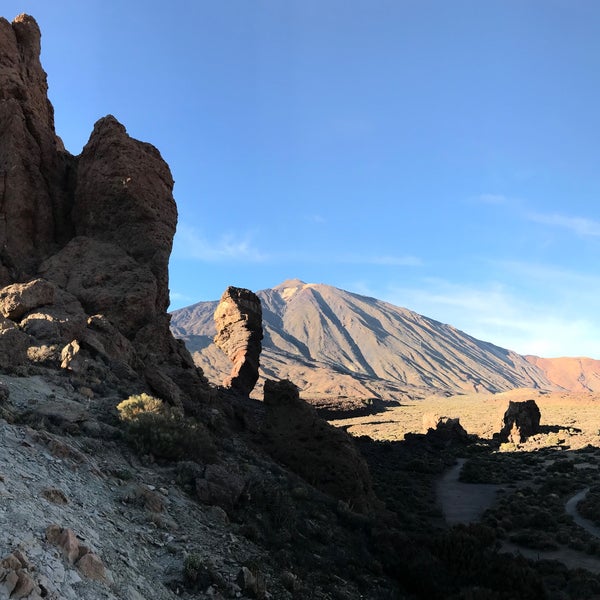
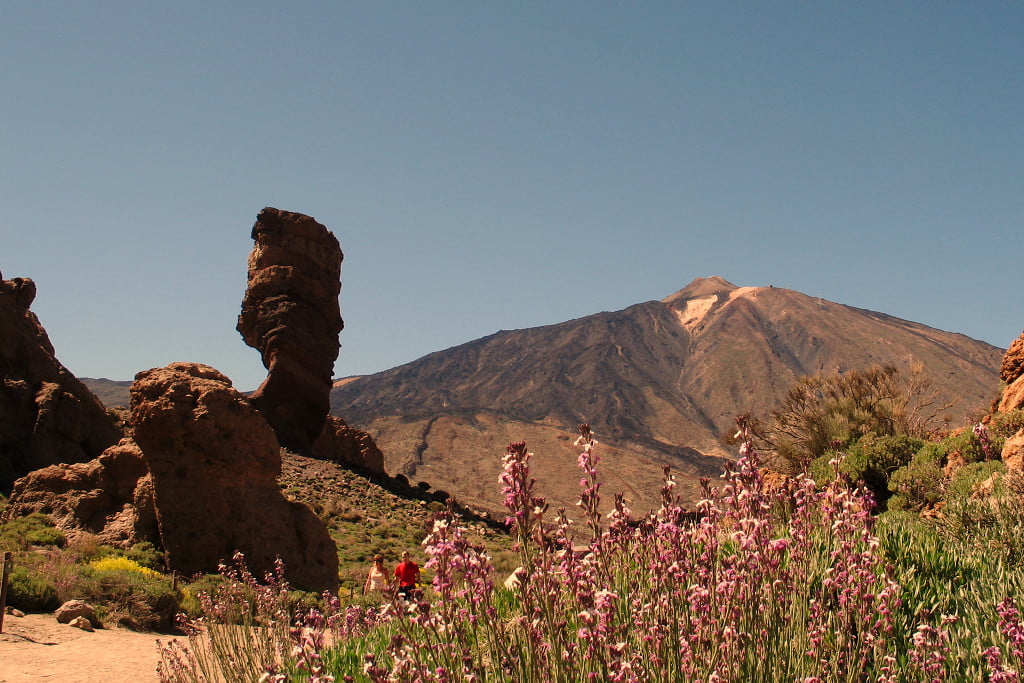

 parador.es/es/paradores/parador-de-las-canadas-del-teide
parador.es/es/paradores/parador-de-las-canadas-del-teide
 The second option is to hike via Montaña Blanca (trail number 7). Given the limited time on the island, the cable car is the option that most visitors normally choose.
The second option is to hike via Montaña Blanca (trail number 7). Given the limited time on the island, the cable car is the option that most visitors normally choose.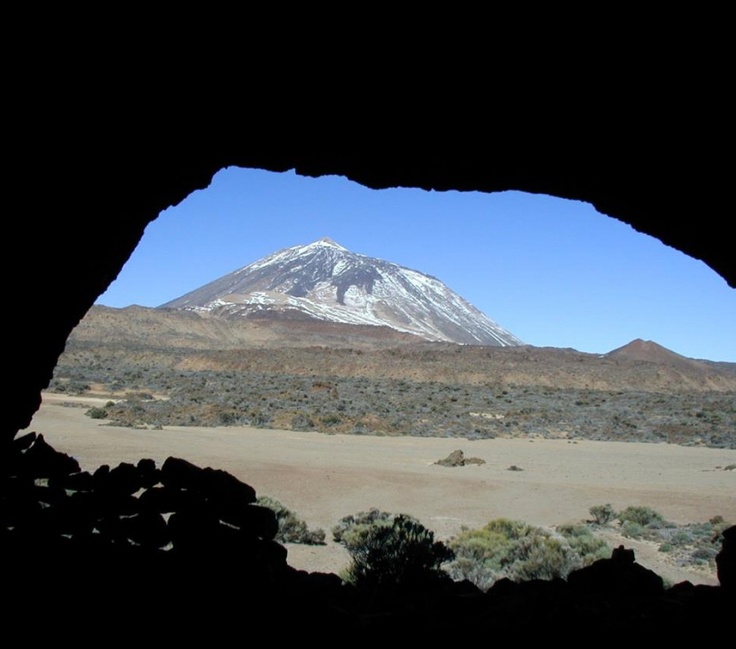
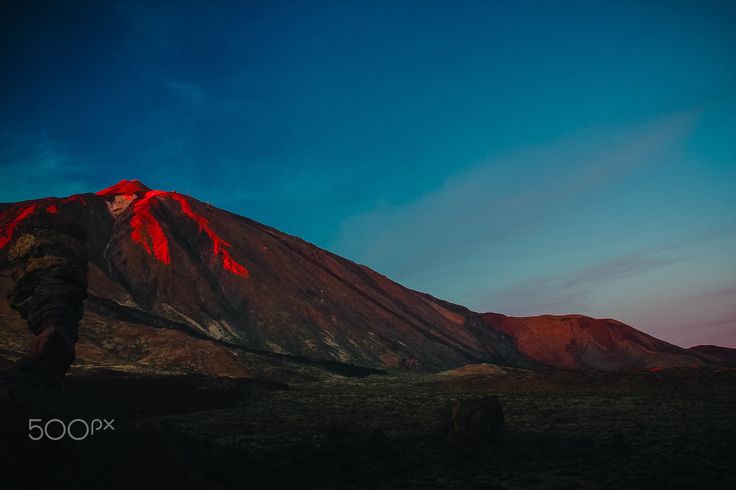 Stays are limited to one night with a prior online reservation. There isn’t a restaurant here, just some vending machines, so you’ll want to bring water and food. Staying at the Altavista Refuge at the Teide Volcano is definitely a great option for watching the sunrise and sunset from the summit. If you stay at Altavista, you’ll be able to get to the peak of Mount Teide before 9:00 am, and you can access the area without applying for a permit. Just be sure to leave the summit before 9:00 am. The Altavista Refuge is currently closed due to Covid.
Stays are limited to one night with a prior online reservation. There isn’t a restaurant here, just some vending machines, so you’ll want to bring water and food. Staying at the Altavista Refuge at the Teide Volcano is definitely a great option for watching the sunrise and sunset from the summit. If you stay at Altavista, you’ll be able to get to the peak of Mount Teide before 9:00 am, and you can access the area without applying for a permit. Just be sure to leave the summit before 9:00 am. The Altavista Refuge is currently closed due to Covid. This is said to be the world’s largest shadow over the sea.
This is said to be the world’s largest shadow over the sea. Meanwhile the Montaña Blanca trail is around 9 km long and it takes between 6 and 7 hours of hiking.
Meanwhile the Montaña Blanca trail is around 9 km long and it takes between 6 and 7 hours of hiking.
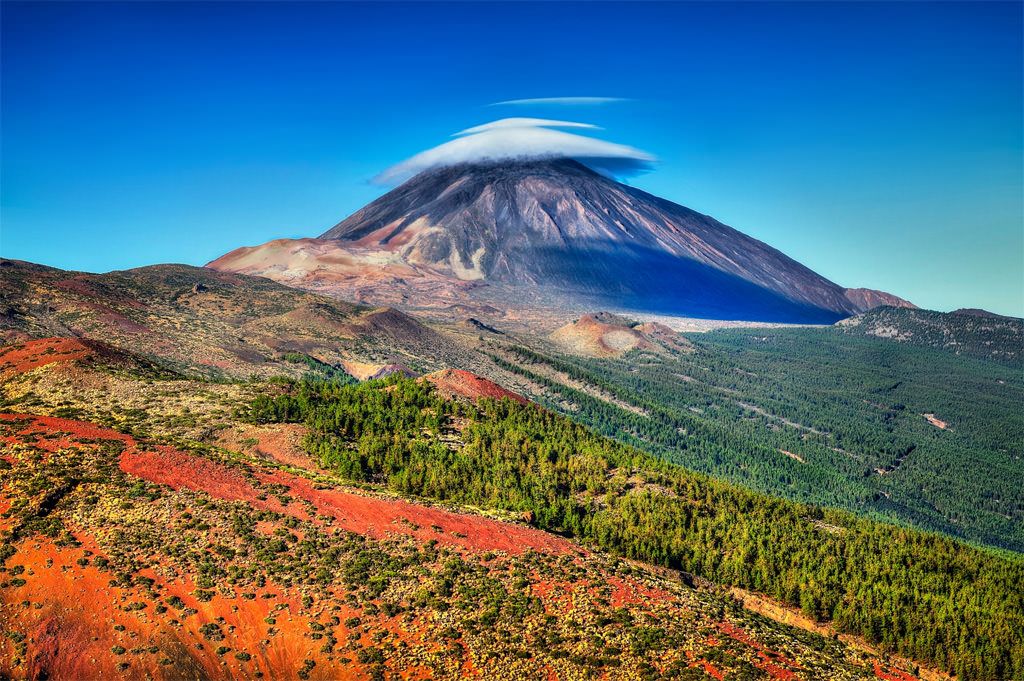 Remember that if you want to hike up to the crater you need special permission which should be obtained online ahead of time from the Reservas de Parques Nacionales website. The permit to climb to the peak of Teide is FREE, meaning there is no cost to be paid, but the registration with date and time is mandatory. The permit cannot be issued on site for any reason. Also know that the number of daily permits to access Teide crater is limited and it is necessary to apply for it at least two months in advance if you want to make sure to obtain one.
Remember that if you want to hike up to the crater you need special permission which should be obtained online ahead of time from the Reservas de Parques Nacionales website. The permit to climb to the peak of Teide is FREE, meaning there is no cost to be paid, but the registration with date and time is mandatory. The permit cannot be issued on site for any reason. Also know that the number of daily permits to access Teide crater is limited and it is necessary to apply for it at least two months in advance if you want to make sure to obtain one. Visitors must choose the period in which they will use the trail. These periods are:
Visitors must choose the period in which they will use the trail. These periods are: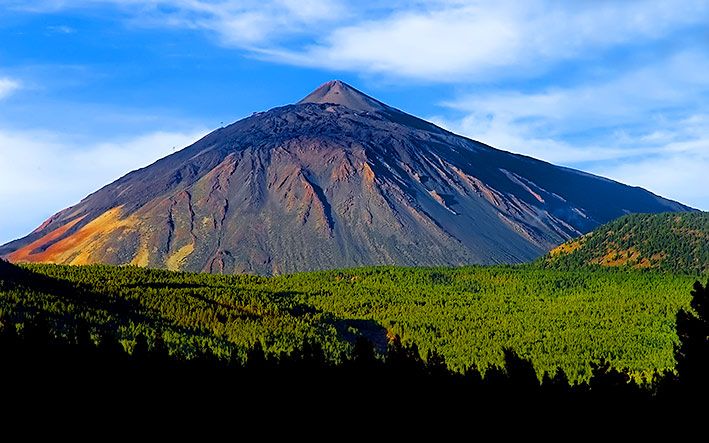 Luminosity at such an altitude is elevated.
Luminosity at such an altitude is elevated. 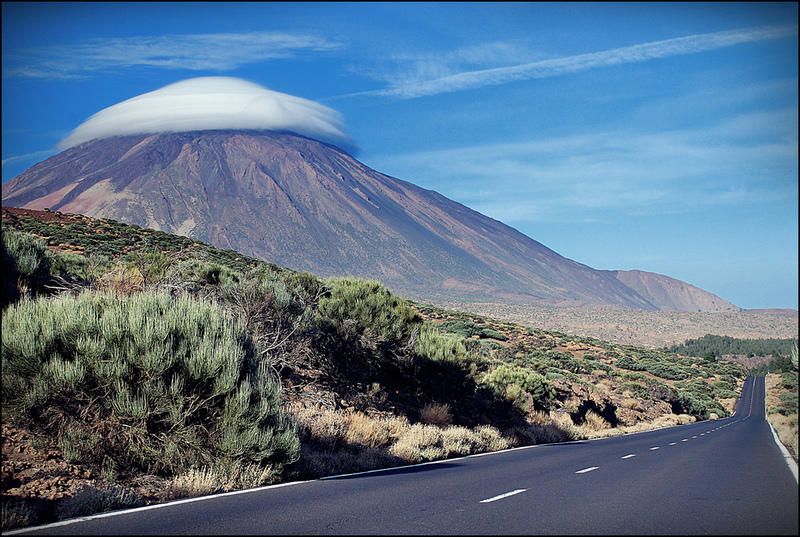
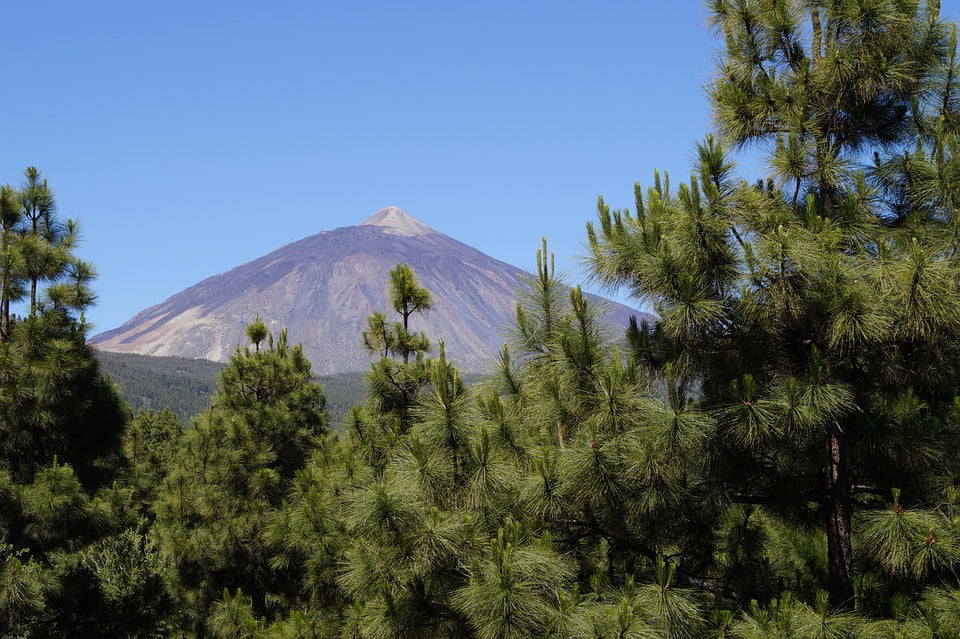 Therefore, tourists here go in jeans and warm jackets, regardless of the time of year.
Therefore, tourists here go in jeans and warm jackets, regardless of the time of year. 

